




Rethinking architecture through a sustainability lens.

An exclusive interview with AIA Gold Medal winners Angela Brooks and Lawrence Scarpa.
Lisa Landrum and Darryl Condon report on the progress towards a National Architecture Policy.
Best practices for implementing carbon budgets in new and exist ing buildings in Canadian cities.


Bringing prefab panellized deepenergy retrofits to Canada.
Advanced MEP systems help reduce the operational energy of buildings but is the high embodied energy cost worth it?
A memoir by Jack Diamond, new research on Canada’s mosques, and local resiliency efforts.
Sputnik Architecture’s passion project to revive local ice har vesting and sculpting practices.
COVER Centennial College Downsview Campus Bombardier Centre for Aerospace and Aviation, Downsview Park, Toronto, Ontario, by MJMA Architecture & Design + Stantec — Architects in Association. Photo by doublespace photography.
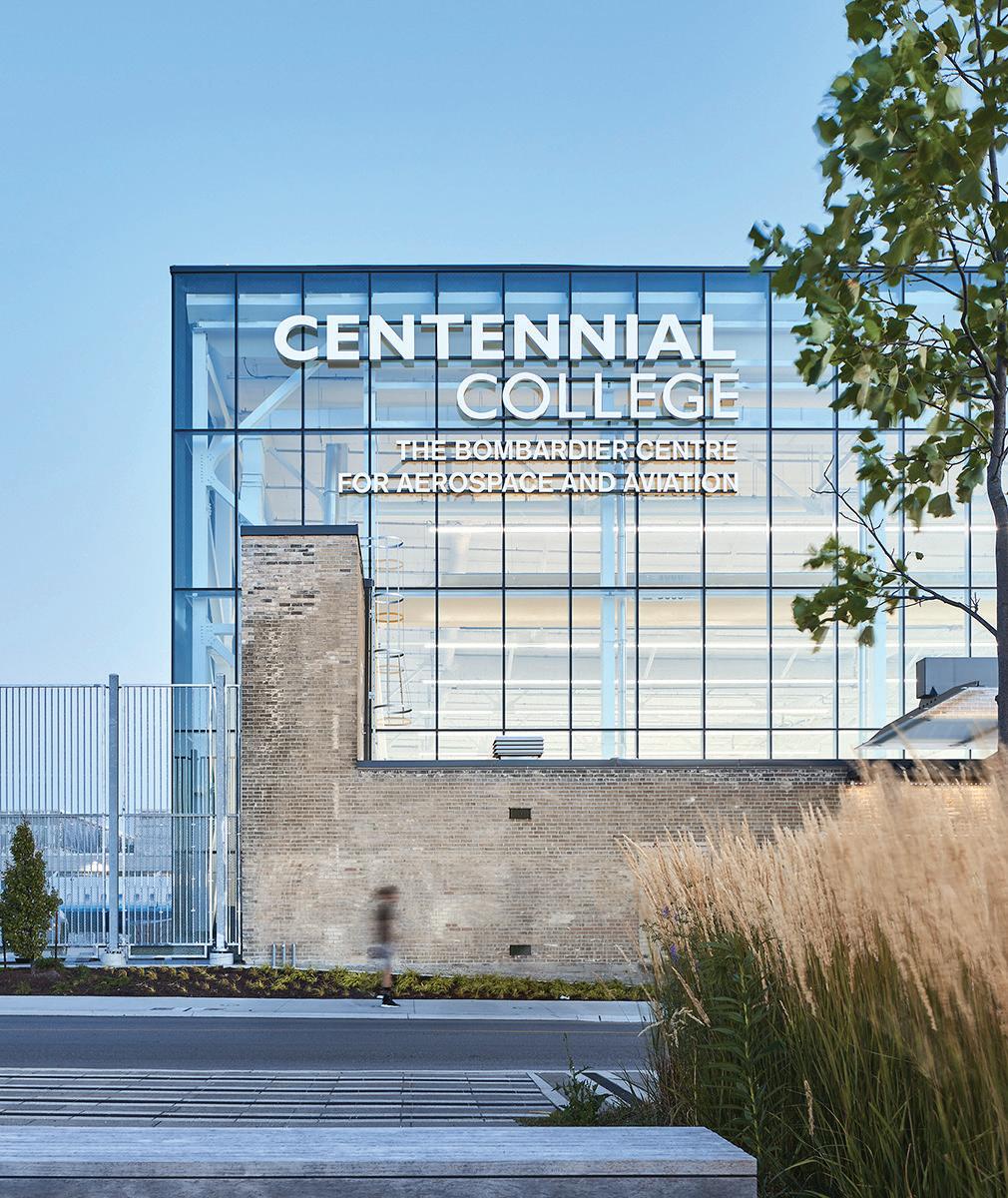
The Intergovernmental Panel on Climate Change’s 2022 report focuses on the impacts of climate change, and the capacities of natural and human systems to adapt. Among its find ings, it notes how the implementation of lowcarbon practices within specific sectors— including buildings—is key to mitigation.
The report highlights strategies such as using more wood in buildings to lower emissions, the wide deployment of green roofs in urban areas to reduce extreme heat, and using passive design strategies for heating, cooling, and ventilation.
But there are also implicit trade-offs: for in stance, enhancing space conditioning in build ings can tame the health risks of extreme heat, but comes with a carbon cost. Tightly sealed buildings reduce energy consumption, but may also lead to moisture build-up in envelopes. Increased insulation without shading and ventilation can come with a lowered ability to benefit from nighttime cooling. And while policy changes can be effective, they can ex acerbate inequities. “Changes to design stan dards can scale quickly and widely, but retrofit of existing buildings is expensive, so care must be taken to avoid potential negative impacts on social equity,” write the report’s authors.
Altogether, “building today for resilience and lower emissions is far easier than retrofit ting tomorrow,” notes the report. Some $90 trillion USD is expected to be invested in new urban development by 2030. It’s “a global op portunity to place adaption and mitigation dir ectly into urban infrastructure and planning,” write the report’s authors. “If this opportunity is missed, if business-as-usual urbanisation persists, then social and physical vulnerability will be not so easily confronted.”
These issues were top of mind for speakers at the Facades+ conference, which convened in Toronto this summer. While many individual architects and researchers are developing exper tise in highly sustainable construction, how do we instigate a change in construction culture, so that higher performance buildings are the norm, rather than the exception? Can we create build ings that radically reduce their reliance on— or entirely eliminate—mechanical heating and cooling? And how do we balance operational energy efficiency with sharp reductions in the embodied energy needed to create buildings?
“We cannot continue with a myopic focus on operational energy, full stop,” said Kelly Alv arez Doran, Senior Director of Performance &
Provenance at MASS Design Group. As director of the Ha/f Research Studio at the University of Toronto’s Daniels Faculty, Alvarez Doran has led research on how to halve the embodied car bon emissions of new buildings in Toronto, using currently available materials and technology.

With his students, he has identified key drivers of high embodied carbon in Toronto’s mid-rise residential buildings—including underground parking areas (made with high embodied-carbon concrete) and aluminum extrusion-based glazing systems (the highest embodied global warming potential by volume of all materials in their study). They’ve also done a deep dive into mass timber buildings, revealing substantial upfront and operational emission reductions achieved by reducing window-to-wall ratios and incorporating mass timber into façades.
Considering façade construction, panellist Cathy McMahon, of Moriyama & Teshima Architects, asked: “How can we be growing the things that clad our buildings rather than extracting them from halfway around the world?” Her firm is collaborating with Acton Ostry Architects on Limberlost Place, under construction for George Brown College in Toronto. They’re aiming to achieve both low operational and embodied carbon: the 10-stor ey building boasts a mass timber structure and was originally designed with terracotta tile cladding (later revised to metal panels due to weight), and has a projected thermal energy demand of 54 kwh/m2/year.
The project team is also geared towards sharing knowledge around the project’s de velopment and design: a three-hour workshop on the afternoon of the conference detailed the technical decisions, construction coordination, and technologies used to design and manufac ture Limberlost’s high-performance prefabri cated façade system. Its structure, too—a beamless system that achieves nine-metre column-free spans, an optimal depth for daylit classrooms— is a non-proprietary system developed by Fast+Epp. “Anyone in Canada can use this,” said Phil Silverstein of Moriyama & Teshima.
We’ve packed this issue of Canadian Architect with recent research and practices in low-carbon construction that we hope will be useful to your work. To move with the speed needed to ad dress the accelerating climate crisis, we will need to learn from each other—and work together.
Summon your ultimate shower with a touch. With the intuitive design of digital controls, supreme power over water is now at your fingertips. Even Poseidon is impressed.



Montreal-based Les architectes fabg has been selected to design the Musée national des beaux-arts du Québec’s Espace Riopelle. The new pavilion will house the world’s largest public collection of works by Jean Paul Riopelle.

The firm was selected through an international competition launched in March. Their design echoes Riopelle’s creative journey by taking shape as a dynamic, climbing path through a signature building. The circuit will culminate in a circular space devoted to Riopelle’s master piece, L’Hommage à Rosa Luxemburg (1992), where visitors will also enjoy views onto the Plains of Abraham and the St. Lawrence River. Wooden ceilings evoke the artist’s studio, while the pavilion's green terraces will reflect the Isle-Aux-Grues landscape.
The Chair of the Board of Directors of the Riopelle Foundation, Michael Audain, together with a group of Canadian philanthropists, has donated $120 million in works and funding for the project.
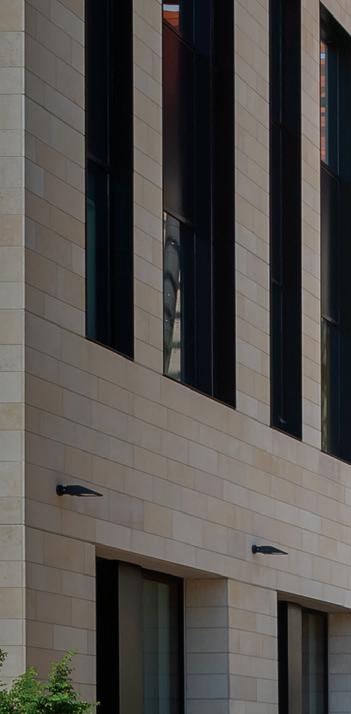
The new building is slated for opening in early 2026. www.mnbaq.org
Designed by Moriyama & Teshima Architects and Bélanger Salach Architecture, Northern Ontario’s first multidisciplinary Francophone arts centre, Place des Arts, has opened in Sudbury.
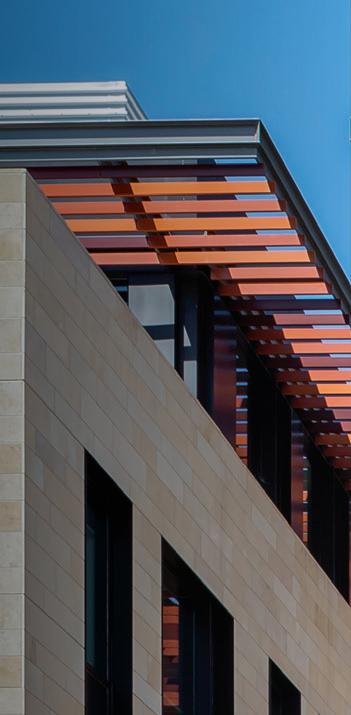

The building includes a 300-seat theatre, a multi-use studio per
ABOVE Les architectes fabg’s winning design for Espace Riopelle, a new pavilion for the Musée national des beaux-arts du Québec.
formance space, a contemporary art gallery, library and national pub lishing house, boutique, bistro, daycare, and offices.
“The architecture of Place des Arts expresses the long history of the Francophone arts community in the Sudbury Region,” says Brian Rudy, Partner at Moriyama & Teshima Architects. “With its sculptural form, the building calls out an invitation to the community, while the use of natural materials such as weathered steel and wood, along with the art istic reuse of historic artifacts on the interiors, provides a welcoming patina and speaks to the deep-rooted presence and hospitality of the community.” www.maplacedesarts.ca
The winners of the Prairie Design Awards, originally scheduled to take place in 2020 but postponed due to the pandemic, have been announced. The awards recognize the top architecture, interior design, landscape, small projects and student projects across the prov inces of Alberta, Manitoba, and Saskatchewan.
Awards of Excellence were given to: Qaumajuq / Inuit Art Gallery in Winnipeg by Michael Maltzan Architecture (Design Architect) with Cibinel Architecture (Associate Architect); Capilano Library in Ed monton by Patkau Architects and Group 2; and the National Music Centre in Calgary by Allied Works in association with Kasian Archi tecture, Interior Design and Planning.
Awards of Merit in the category of Recent Work went to 62M in Winnipeg by 5468796 Architecture; Grow in Calgary by Modern Of fice for Design and Architecture; Kathleen Andrews Transit Garage in Edmonton by gh3* (design architect) with Morrison Hershfield (prime consultant); Parkade of the Future in Calgary by 5468796 Architecture in collaboration with Kasian Architecture, Interior Design and Planning; Manitou a bi Bii Daziigae at RRC Polytech in Winnipeg by Diamond Schmitt Architects in joint venture with Number TEN Architectural Group; Windsor Park Library in Winni peg by david penner architect + h5 architecture.
In the category of Interior Design, Awards of Merit went to Attabot ics Headquarters in Calgary by Modern Office of Design and Archi tecture and Snider Orthotic Design in Winnipeg by 1 x 1 architecture.
Landscape Architecture Awards of Merit were given to 5th Street Underpass Enhancement in Calgary by the marc boutin architectural collaborative, Manitoboggan in Winnipeg by Public City Architec ture, and Paul Kane Park Redevelopment in Edmonton by GEC Architecture.
Two Small Projects Forest Pavilion in Winnipeg by Public City Architecture and Rainbow Butterfly in Winnipeg by a group of In digenous designers at Brook McIlroy also received Awards of Merit.
The jury included James Brittain, D’Arcy Jones, Bruce Kuwabara, Elsa Lam, Lola Sheppard, and Mark van der Zalm, and the program received 166 submissions. www.prairiedesignawards.com
The Northwest Territories Association of Architects has announced the winners of its 2020 Architectural Awards and Architectural Photog raphy competition.
The program’s top distinction, the Awards of Honour, went to three projects by Taylor Architecture Group: Łutsel K’e Dene School Addi tion/Renovation, Kugaaruk Hamlet Office Community Hall, and Liard Highway Welcome Pavilion. The firm also received Awards of Merit for Łutsel K’e Dene School Landscape Design and Gjoa Haven Hamlet Office. Stantec Architecture’s Iqaluit Aquatic Centre was also recognized with an Award of Merit.
Citations were awarded to the MacBride Museum Addition & Reno vation in Whitehorse by Kobayashi + Zedda Architects, the Iqaluit International Airport Improvement Project by Stantec Architecture, and the Haines Junction Lift Station by Stantec Architecture.

All our architectural products serve a distinct, functional purpose. From louvers to wall coverings to every detail we perfect. But, at the same time, we never lose sight of the a ect a building has on people. The inspiration it provides. The satisfaction it brings to all who enter. For 70 years, we’ve based our success on the idea that putting people rst is the foundation for building better buildings. And, for 70 years, our partners have depended on us for architectural product solutions. Are you ready to think beyond the building with us? Visit c-sgroup.com.

The second edition of the NWTAA’s architectural photography com petition recognized photographs by Patrick Fung and Wayne Guy. www.nwtaa.ca
Landscape designer, scholar, activist and educator Jane Wolff has received the 2022 Margolese Prize. The $50,000 award recognizes a Canadian designer in early to mid-career whose work and advocacy in the built environment address the pressing human and environmental challenges of our time and improve peoples’ lives and communities.
Wolff, a professor at the John H. Daniels Faculty of Architecture, Landscape, and Design at the University of Toronto, works to build collective understanding around landscape design’s role beyond its physical presence. She designs playful tools that encourage people to understand and participate in the future of landscapes that surround them capabilities urgently needed in a rapidly changing world.
“Jane Wolff’s work on landscape literacy has had a significant im pact on our collective understanding of critical environmental issues,” writes the jury. “Her human-centric tools of writing, hand drawing and public engagement reach a wide audience without compromis ing the complexity of the subject matter.”
Wolff’s work includes the Gutter to Gulf website, an open-access tool that explains the history, engineering, and possibilities of New Orleans’s water systems; Bay Lexicon , a visual dictionary about San Francisco’s shoreline that reveals the implications of sea level rise; Delta Primer, a book and deck of playing cards that describe the fiercely contested ecosystem of the California Delta in terms that transcend the usual boundaries of interest groups; and the co-curation of the Toronto Land scape Observatory, an interactive exhibition that invited Indigenous and settler knowledge keepers, scholars, and artists to create instruments for observing the environment.
www.margoleseprize.com
Moshe Safdie has donated his professional archive to his alma mater, McGill University, and pledged his personal apartment at Habitat 67 to ensure that it remains a resource for the university, and the public at large.
“I have always valued the great education I received at McGill that has guided me through my professional life. Moreover, Canada has em braced and supported me, making possible the realization of several seminal projects. It is therefore fitting that McGill, Quebec, and Can ada will be the home of my life’s work,” says Safdie.
The archive features over 100,000 pieces, including loose sketches, sketchbooks, models, drawings, and correspondence related to unbuilt and built projects across the globe.
The original model and master copy of Safdie’s McGill undergradu ate thesis, ‘A Case for City Living’, which inspired his design for the Habitat 67 residence, is also included.
Safdie’s personal apartment at the Habitat 67 housing complex will be the centrepiece of the archive. The four-module duplex unit will serve as a resource for scholarly research, artist-in-residence programs, exhib itions, and symposia, thereby expanding the impact of the collection.
Fondation Habitat 67, a non-profit foundation, will collaborate with McGill on the preservation and maintenance of the apartment as part of its mandate to promote the property for public educational activities.
“On behalf of the McGill community, I would like to express our

gratitude to Moshe Safdie for his remarkable gift,” said McGill Principal Suzanne Fortier. “This is a historic moment for McGill. One of the most influential and important architectural archives in the world, from one of our most celebrated graduates, will forever be a part of our University.” www.mcgill.ca
Carleton University’s Azrieli School of Architecture & Urbanism has appointed architect, historian and educator Anne Bordeleau as its new Director for a five-year term commencing on January 1, 2023. Bordeleau spent 15 years with the University of Waterloo’s School of Architecture, where she served as O’Donovan Director since 2016. Her teaching, research and practice have covered many fields, from nineteenth-century architectural history and theory, to modern cultural history, to accessibility and the broadening of the discipline. She is one of four principals who worked on The Evidence Room , an exhibition in the central pavilion of the 15th Venice Architectural Biennale in 2016.
In her roles within the university as well as across multiple organiza tions in Canada and beyond, Bordeleau has been been looking at the ways in which architectural education and organizations frame our idea of the architect as well as architecture’s role in society. architecture.carleton.ca
According to a recently released Statistics Canada report, “Forging Ahead During the Pandemic: How Selected Service Industries Bounced Back in 2021,” revenue from architectural services made a strong comeback
last year. The report shows that revenue for architectural services rose 15.4 per cent, surpassing pre-pandemic levels by more than 1/10. Much of this growth can be accounted for by residential construction which hit an all-time high in 2021 as well as business and public investment in non-residential buildings.
In 2021, residential construction made its largest contribution to gross domestic product since comparable data became available in 1962. “Low interest rates and the need to accommodate teleworking boosted housing starts by 24.5 per cent to 271,198 units in 2021, with both single and multiple dwellings in high demand,” says the report. “In addition, busi ness and public investment in non-residential buildings posted strong growth, further strengthening the demand for architectural services.”
The report also noted how specialized design services benefit from retrofitting of physical spaces and improving economic conditions.
“The pandemic disrupted many facets of how businesses and the popu lation in general interact in physical spaces. Specialized design services, mainly interior design services, helped people connect and improve vir tual and physical interactions and experiences, in terms of both lifestyle and business,” it notes.
The website of the Ontario Association of Architects (OAA) includes a 2018 report by Altus Economic Consulting that confirms economic activity from the architecture industry’s entire footprint in Ontario to talled $128.4 billion, or 14 per cent of the province’s GDP www.statcan.gc.ca / www.oaa.ca
For the latest news, visit www.canadianarchitect.com/news and sign up for our weekly e-newsletter at www.canadianarchitect.com/subscribe
We’ve welcomed four on trend colours to our Architectural Series family, starting with Creekside, Shadow Ridge, and Spring Hill, each in matt and velour finishes. These sophisticated, neutral tones lend modern elegance to commercial and residential projects. Our new White Ash brick, featuring an iron spot finish, delivers a light brick with a hint of old-world character.


Savings by Design
Youdale,
Development
Success Story
OttawaPassive House
Housing

ne of the common threads woven throughout the AIA National Confer ence held in Chicago this June was that of Diversity, Equity, and Inclusion. DEI considerations have become more and more prevalent in how we structure our teams to better mirror the clients that we serve. But this is only the initial mechanism for steps we must take to truly make a difference in our built environment.
I was in attendance for Angela Brooks and Lawrence Scarpa’s acceptance of this year’s AIA Gold Medal. They were celebrated in part for their deep portfolio that models the possibilities for centering social purpose with in complex and beautiful design responses. In recognizing them, we have the opportunity to find inspiration and to realize what is indeed possible when we blend policy commitment with great design. Brooks and Scarpa work to shift the conversation with neighbours, chang ing the perception that all affordable housing and its occupants are undesirable. Instead, they demonstrate that thoughtful design brings value to both the neighbourhood and the residents.
My greatest takeaway was a reminder of architecture’s power to either help or harm people. There is no turning back the tidal wave of awareness that came upon us with the #MeToo movement, Black Lives Matter, and inaction on the Truth and Recon ciliation Commission’s Calls to Action, among many other issues. The time is now to make an immediate plan of action on how archi
tects can get involved in the larger commu nity, along with non-profits and change agents, to leverage the best outcomes for socially minded work.
AIA Canada Society’s Director of Diversi ty, Equity and Inclusion, Pauline Thimm, sat down with Angela Brooks and Lawrence Scarpa to discuss their path to bringing poet ry to problem-solving in the built environ ment. We have also included a profile of the AIA’s Housing and Community Development Knowledge Community for some readily available resources to support our members’ journeys along one branch—affordable hous ing—of design inclusivity and equity.
The AIA Housing and Community Development Knowledge Communi ty (HCD) is a network of approxi mately 12,000 architects and allied stakeholders that promotes equity in hous ing, excellence in residential design, and sustainable, vibrant communities for all, through education, research, awards, and advocacy. Their mission is to track housing issues and develop relationships with indus try stakeholders to encourage and promote safe, attractive, accessible, and affordable housing for all.
Each year, the HDC sponsors an awards program that emphasizes the importance of good housing as a necessity of life, a sanctuary for the human spirit, and a valuable national resource. The jury evaluates entries relative to the AIA Framework for Design Excellence, with considerations including equity, resilience, innovation and delight.
Following this year’s announcement of award winners, a moderated panel discussed the winners’ approaches to addressing various challenges through design. Panellists discussed the design criteria used as the basis of selec tion, including the role of housing as an oppor tunity to rethink diverse forms of living, inno vating to combat shortages, and how to pro mote sustainable, responsible designs.
The Housing and Community Development Knowledge Community’s seminars are avail able for AIA and AIA Canada Society members to view at no cost. aia.org/hcd

AIA Canada Chapter Board of Directors has openings for both the Treasurer and Secretary positions commencing January 2023. If interested, please reach out to Rommy Rodriguez at rommy@aiacanada society.org for a nomination form. Nomi nations are due October 31, 2022.

The submission deadline for this year’s AIA Canada Design Awards is October 28, 2022. Winners will be published in the AIA Canada Society’s Journal, within the pages of Canadian Architect. Two winners will be selected to participate in the 2023 awards program with the AIAI at no addi
tional cost. Submission categories include: Architecture, Interior Architec ture, Special Projects, Urban Design, Community Engaged Design (new catego ry—entry fee waived) and Student. The winning student will receive a $1,000 scholarship.
the artistic endeavour. They don’t need to be mutually exclusive. We consider ourselves artists—plying our trade to the highest stan dards—and we also do it with purpose.
ideas. I was a frustrated urban planner—I just didn’t know it then!
In those early years, we worked together on ‘fun’ things—like competitions—on the weekends. We eventually started working together, first with another partner until 2010, and then with just the two of us as partners for the last 12 years.
AB: We work with non-profit developers [such as Livable Places] who tell us that good design makes people heal. It doesn’t necessarily cost more to design well, in fact, it often costs less because you are design ing in a way that is reflective of a symbiotic relationship to how people really live.
The winners of the 2022 AIA Gold Medal, the organization’s top award, are Angela Brooks, FAIA and Lawrence Scarpa, FAIA, co-founders of the Hawthorne, California–based firm Brooks + Scarpa. Those famil iar with their work will not be surprised to learn that this well-deserved honour has been over 30 years in the making—with much more in store.

AIA Canada Society’s Pauline Thimm caught up with Angela Brooks and Lawrence Scarpa this July to find out more about what they stand for, how they have evolved, and where they are going.
Pauline Thimm: On behalf of AIA Canada, I am thrilled to congratulate you on your Gold medal win. At this moment of intense interest, how would you like people to know you?
Lawrence Scarpa: We want to be known as ‘artists who are citizen-architects’. We really believe that good design is for everyone. Art and craft are important, and that has always been part of the artistic mission, but purpose is equally important. We work with purpose.
Angela Brooks: Not everyone knows that we did not start out working together. We first met in architectural school in Florida, and moved to California after school. Larry started a small practice with another part ner. I started out working for a non-profit development company, to get a more prag matic understanding of how communities are developed. I was never really interested in only designing a singular building—I’ve al ways been interested in exploring the bigger
LS: I also worked with Paul Rudolph early on. I used to dig out archived drawings when we worked with historic structures. They were incredible to see—sometimes just four sheets, with simple notes like “contractor to build best quality possible.” We can’t even do general notes like this anymore, let alone an entire drawing set. It is really a different world, and it requires a team effort. It takes a lot of expertise; it takes a combination of strengths in many, many areas. As a firm, we think of ourselves as a small soccer team that comes together around projects—every body does everything at Brooks + Scarpa. Angie and I complement each other with real and equal strengths and interests. Now we work alongside each other every day. Thinking how to work through a project, Angie starts off with the big-picture context, I take it through the design stages, and Angie closes it—she is so detail-oriented.
AB: I believe that in another life, Larry would have been a sculptor. He is a true artist— and he is always designing.
In our current era, there is an emerging recognition of social purpose in architec tural awards—with this AIA Gold Medal, as well as with recent Pritzker Prize winners. How do you see this evolution, and how do we keep moving forward from here as a profession?
AB: There was also this year’s AIA Firm Award for MASS Design, as part of this increased recognition of social equity and climate justice.
LS: We are just doing what we think is right. We are lucky that people think that what we have done—and continue to do—has mean ing. The aspect of doing work that matters for other people is equally as important as
AB: Our profession has so much to give back to our communities, but often by the time architects get involved, all the big decisions have been made. We have always felt that we could make a bigger impact designing for under-resourced people and communities. And now we know that’s true.
LS: It’s not just for—or about—us, it’s for the greater good. We’re lucky that the stars align now, and that others think this approach is important too. It’s a great trend.
You’ve noted that you don’t want Brooks + Scarpa to be viewed as a brand, and you eschew labels. Why is this important? How does this impact the work you are able to do?
LS: Everyone wants to pigeonhole design ers today—as school designers, affordable housing designers, etc. We’ve always been interested in doing a lot of different things— there is a lot to learn and contribute. Our goal is: “Don’t plagiarize yourself!” This can hap pen when you get branded and end up doing the same thing repeatedly. It can sometimes lead to having less and less impact.
AB: Sometimes, when working on a project type you’ve never worked on before—you can bring a fresh perspective.
LS: It’s not rocket science to do different ty pologies, but we aim to do it well. We tend to pick the things that are not seen as glamour ous and where the existing work is often re ally bad. In affordable housing, for example, we initially thought it wouldn’t take much to be a hero; we found out it wasn’t easy. We like those kinds of challenges—when it is not just about the design potential, but the chance to provide good design to those who don’t ordinarily get it.
AB: I’ve asked Larry, “Can’t we just do the same project type twice? Do we have to
Top: The SIX is a 52-unit affordable housing project in L.A. that provides a home, support services, and rehabilitation for disabled veterans. It includes generous public areas, including a large raised court yard, that encourage community-oriented living. Above: Located in Santa Monica, Colorado Court Housing is a five-storey affordable housing project that is designed to be 100-percent energy indepen dent, providing a model for sustainable living.


do something completely different every time?” I realize now how our approach has made Brooks + Scarpa stronger, though. Because we have such a diverse range of project types, and as a team we represent a lot of different interests, our diversity has helped us weather adversity. We survived the 2006 recession because we had so many different things happening—it’s what kept us going.
The rigour and discipline brought to your work is really apparent, as well as a deep sense of curiosity. The inherent beauty of
the resulting design response is so often complex and layered. What feeds your curiosity?
LS: I’m always interested in finding a better way. And I teach. I tell my students, “I am here to learn as much as to teach.” I’m inspired by how students take the most mundane things and turn them into a design prob lem. It’s always interesting and usually not something I would have necessarily thought about. I am always learning something.
It’s also important to always be aware of what is right in front of you—to try to tell
the story of what is already there. There is so much to learn right in front of your face!
AB: And we bring our strength as big-idea thinkers. It’s so hard to take an idea from concept through to construction. Everyone who works with us is a good designer who sees and knows what good design is—they all understand. This is how we are able to consistently deliver on our big ideas, even if there has been an evolution of the details.
Can you build on that notion of delivering the big idea and talk a little bit about your design process, including how you give voice to the user? Do you engage in post-occupancy evaluation as part of your process?
AB: Brooks + Scarpa is really good at carry ing the key design thread through a project. We would never give the construction phase to someone else—we are involved all the way through. Even after construction is complete, we’ll go back to the client and see how things worked out. We really like surveys—and not just those that are sustainability-focused for the energy side of the analysis, but also sur veys for the users. We ask: How is it working? What do you like? What don’t you like?
We translate this thinking and this feedback beyond the building to its context— constantly thinking about the larger view, the bigger ideas around the projects and in the neighbourhoods where we are putting people. When we create multi-family hous ing, dense housing, and affordable housing projects, we really want it to be near transit, or in commercial areas or zones. We are constantly telling the story of how neigh bourhoods are for everyone.
Our profession could do a better job of telling the story about how communities can look in the future and how they can be better. Then those deciding where transit goes, how wide streets will be, and how dense projects can be around transit will actually see that this is where we could go.
Our commitment to the follow-up has created a lot of repeat clients for us. The message is that beyond good design, we are shepherding the process all the way through, and we are going to make this work for you in the best way possible, so you will end up with a great, well-designed project. We really care about that. And we know this means a lot to our clients as well.
You have spoken about how you’ll often come to a project and rework the design problem, as a way to address the big
good design. We believe that if you do these common sense things that make a place good to live in, the building will have longev ity. If it’s just an exercise in form-making, it’s not as likely to have a long life.

I like to quote James Wines [architect and founder of SITE Environmental Design] who in essence says that a building that is an energy hog that everyone loves is ultimately more sustainable than a net-zero building that no one likes or wants to live in. In other words, if anything is to have longevity or sustainability, it has to be loved. It comes down to fact that good design matters. If you can inspire people with what you do, they will love it and care for it. If you don’t treat it that way, it will not last.
Is there a design problem out there you are dying to get your hands on?
The Unplanning Miami research project investigates a new framework for urban design and architec ture that uses amphibious strategies to adjust to rapid sea-level rise—a necessity for adapting to cli mate impacts in South Florida.

picture. How do you tackle that, so that the design problem is understood to be more holistic and community-based? How do you bring clients along on that journey?
AB: It really depends. Effecting change is sometimes hard to do on a single project, so we’ve created projects for ourselves. We get involved in really knowing the policy context, the zoning code. We take our lumps, and always ask how we can do better next time. It usually comes down to the ability to change the code in some way, or finding additional money. For our Colorado Court housing proj ect, Larry found half a million dollars of un used grant money with the utility companies that could pay for the project’s solar panels.
LS: Brooks + Scarpa wrote the Small Lots Ordinance for the City of Los Angeles [passed in 2005 to regulate the construc tion of single-family infill housing and restore small lot development] and we have affected state-level policy change on the energy code. It took threatening to sue the state, and enlisting state representatives to agree it was a good idea. We believe the effort is worth it—getting a policy change in place changes it for everyone. We also real ize that, for better or worse, policy is not permanent—in fact, it is less permanent than the buildings themselves.
AB: We’ve found that when clients see that you are all-in, that you will do what you need

to do to get it done, people tend to get onboard and help you. They see you are work ing towards a vision that it is bigger than just a project. A recent example, in our era of mass shootings and hardened schools, is the need to deliver projects that are fullysecure—with bullet-proof glass, gates, etc. It’s about showing the client how there can be multiple solutions—that through design, you can make a project feel really open and look really open, yet be completely secure.
LS: It’s not always easy, sometimes you have to wear them out. You need a bag of tricks. And sometimes you still lose.

AB: We are persistent. We show our clients that we will figure out a way to make it work.
Thinking about the life of a project, and how inhabitants and the building will function in the future, how do you approach design solutions tuned for the next 100 years?
AB: The way we approach and talk about projects really depends on who the owner is, and their stake. Long-term owners are often easier to talk with—they want a build ing that will last into the future.
LS: We focus on things my grandmother would say are just good Jewish common sense: natural light, cross-ventilation. We know these elements are the foundation of


LS: Climate change—sea level rise and coastal areas, specifically. Our Founding Peoples have always lived near water. We need water to survive. We are at a time now where all major places to live that are near water are on track to a catastrophic future. Brooks + Scarpa has spent the last five years writing an elaborate manual for coastal adaptation for the east coast of Florida, where sea level rise issues have been occurring for over a decade.
AB: The City of Fort Lauderdale hired us because they wanted creative minds who would think outside of the box—they wanted experts to apply design thinking to the complex problem. They enlisted designers to lead multidisciplinary teams of coastal biologists, engineers, and others to really think about what the future will look like.
This is the type of complex problem that architects can lead. We have the design pro cess and vision to bring everyone else along. We have the capacity and skill to be not just problem solvers—but to be problem-setters. We are the ones who can identify the true nature and scope of the problem into the future, and then start to think about how we can go about solving it now.
It would be great if more of us could get involved in the design of infrastructure. As architects, we are ideally suited and should be involved in this bigger picture context, and in visionary future-thinking. This is where the profession can start to evolve and grow.
Architect Pauline Thimm is an Associate at DIA LOG, and AIA Canada Society’s Director of Diversi ty, Equity, and Inclusion.
















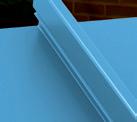














































































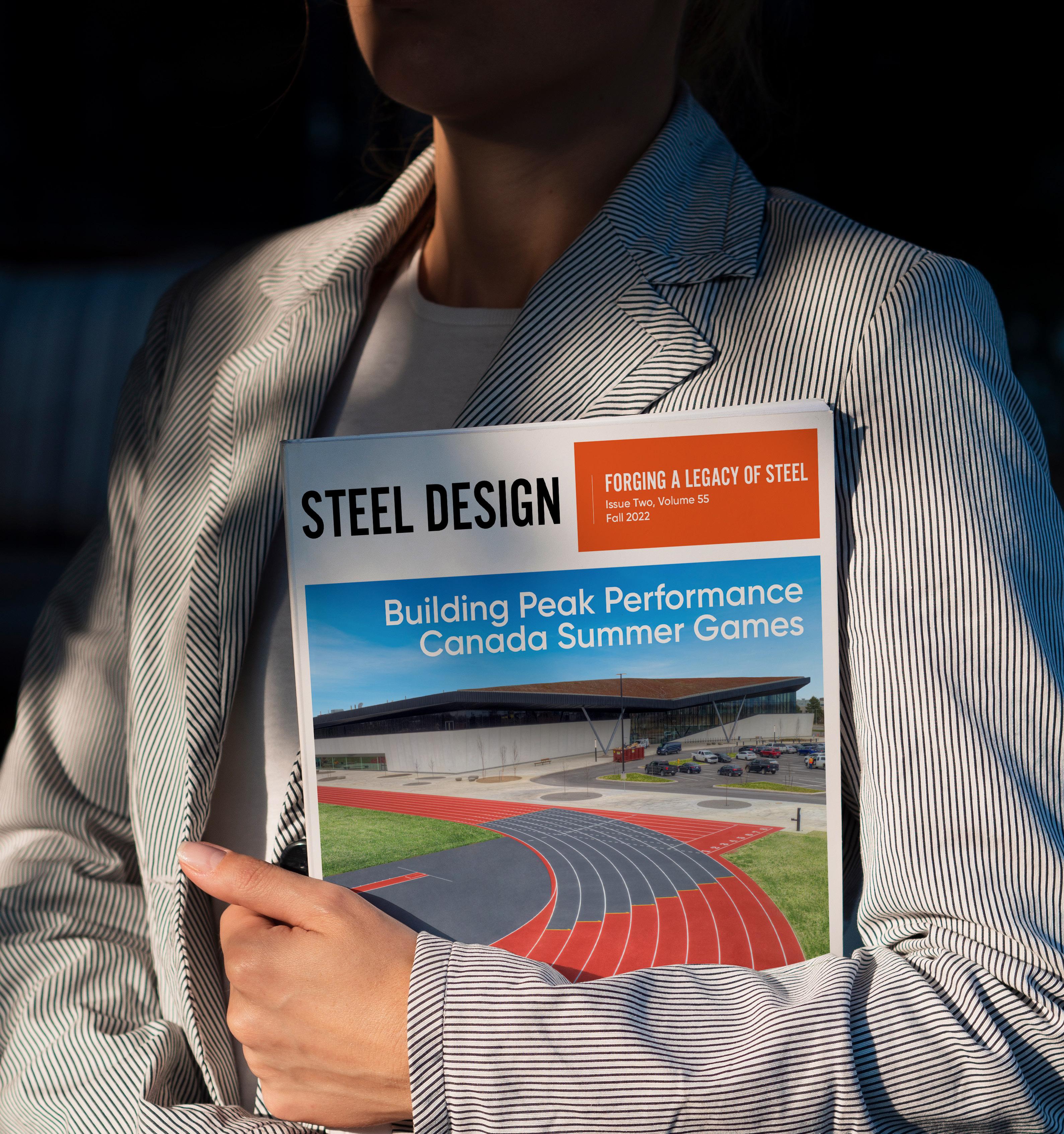
Since 2016, a task force of Canadian architects and educators has been mobilizing conversations on the future of architecture and developing a framework for an architecture policy for Canada. The group shared their preliminary work in a 2019 Canadian Architect interview. Editor Elsa Lam reconnected with this group now called Rise for Architec ture to check in on their progress and plans.
Elsa Lam: When we last spoke in 2019, your group was planning an ambitious series of consultations with architectural professionals as well as student groups, aimed at informing a national policy that would highlight the value of architecture, helping to feed public debate and influence legislation. How did those consultations go?
Darryl Condon: Just before the pandemic, we talked to over 2,000 architects from across Canada roughly 20% of the profession. These
face-to-face workshops took place at the 2019 RAIC conference in Toronto and at regional meetings from St. John’s to Victoria to Yellow knife. When COVID cancelled our planned coast-to-coast consulta tions with Canadian communities, we reinvented our public outreach strategy with an online platform. Rise for Architecture launched in 2021, and results from an Angus Reid poll were published in April 2022. Overall, we’ve heard from nearly 5,000 Canadians, most of whom are keen to help shape better built environments and support an architecture policy for Canada.
Lisa Landrum: The Canadian Architecture Forums on Education (CAFÉ) began in September 2019. The series brought together all 12 Canadian schools of architecture in conversations about the profession’s future. Five forums were held at five campuses in Halifax, Montreal, Toronto, Winnipeg and Calgary involving nearly 1,000 students,

More than 30 countries have or are developing architecture policies.
academics and community members. The last CAFÉ took place in March 2020. Online forums, a survey, and a manifesto competition continued through the summer, and a Summary Report was published in September 2020. This year, we created “CAFÉ Capital: Towards Equity in Architecture,” with three online workshops and an in-person forum in Ottawa, from September 29 to October 2.
DC: Again and again, we heard about the desire for change. Architects believe in architecture’s potential to make positive social and environ mental impacts. But they also feel constrained by inflexible procurement and regulatory processes that put profits and risk aversion over long-term value. From the public, we heard general dissatisfaction, but also encour aging evidence that they value good design. Results of the 2022 Angus Reid Poll show that most Canadians do not see themselves, their culture, and their values reflected in the places they live. People further feel dis connected from decision-making processes shaping their communities. Our survey results confirmed these findings, with 76% of respondents supporting better design and planning policies.
LL: The voice of the next generation of architects resounds with crea tivity, conviction and hope. The CAFÉ series had five key takeaways: 1) Engage architecture as a tool for climate action; 2) Engage archi tecture as a tool for social justice; 3) Enable radical diversity in the profession and radical accessibility in the built environment; 4) Pur sue architectures of healing and enjoyment at multiple scales and sensibilities; and 5) Support holistic design excellence, communityengaged processes, and Indigenous empowerment. We also learned that architecture’s future is a trans-generational project. New stu dents and seasoned practitioners have much to contribute and to learn from one another.
How did the pandemic affect your group’s methods? Has the mission of your group been adjusted to take account of lessons-learned from the past two-and-a-half years, when Canadians have been interacting with architecture especially public architecture in different ways?
DC: Challenges in the last couple of years have underscored the need for the architectural profession to renew its social contract with the public it serves. Access to safe and healthy environments, affordable homes, and inclusive and inspiring public spaces has never been more important. Moreover, the climate catastrophe is accelerating. Living in Vancouver, I have seen the unprecedented floods and fires of the last two years. Resilient infrastructure and sustainable buildings are top priorities. The socio-political and environmental contexts in which architects work are rapidly changing. Yet, many of our professional frameworks are static. It’s time for change!
LL: Remote learning magnified problems of accessibility in architectur al education. The pandemic was a wake-up call for well-being and work-life balance. There are also renewed calls for anti-racism and social justice. The Black Lives Matter movement and the painful con firmation of unmarked graves at former residential school sites have impacted academic institutions and architecture programs in sobering ways. Most schools have formed Equity, Diversity and Inclusion com mittees and committed to decolonizing curriculums. Yet, biases of gender, race and class are entrenched. Addressing systemic racism in Canada’s architecture schools , as school director Anne Bordeleau has explained, is a slow process (see CA, Feb 2021). This fall’s CAFÉ ,
Equity in Architecture,” encouraged open discussion
these
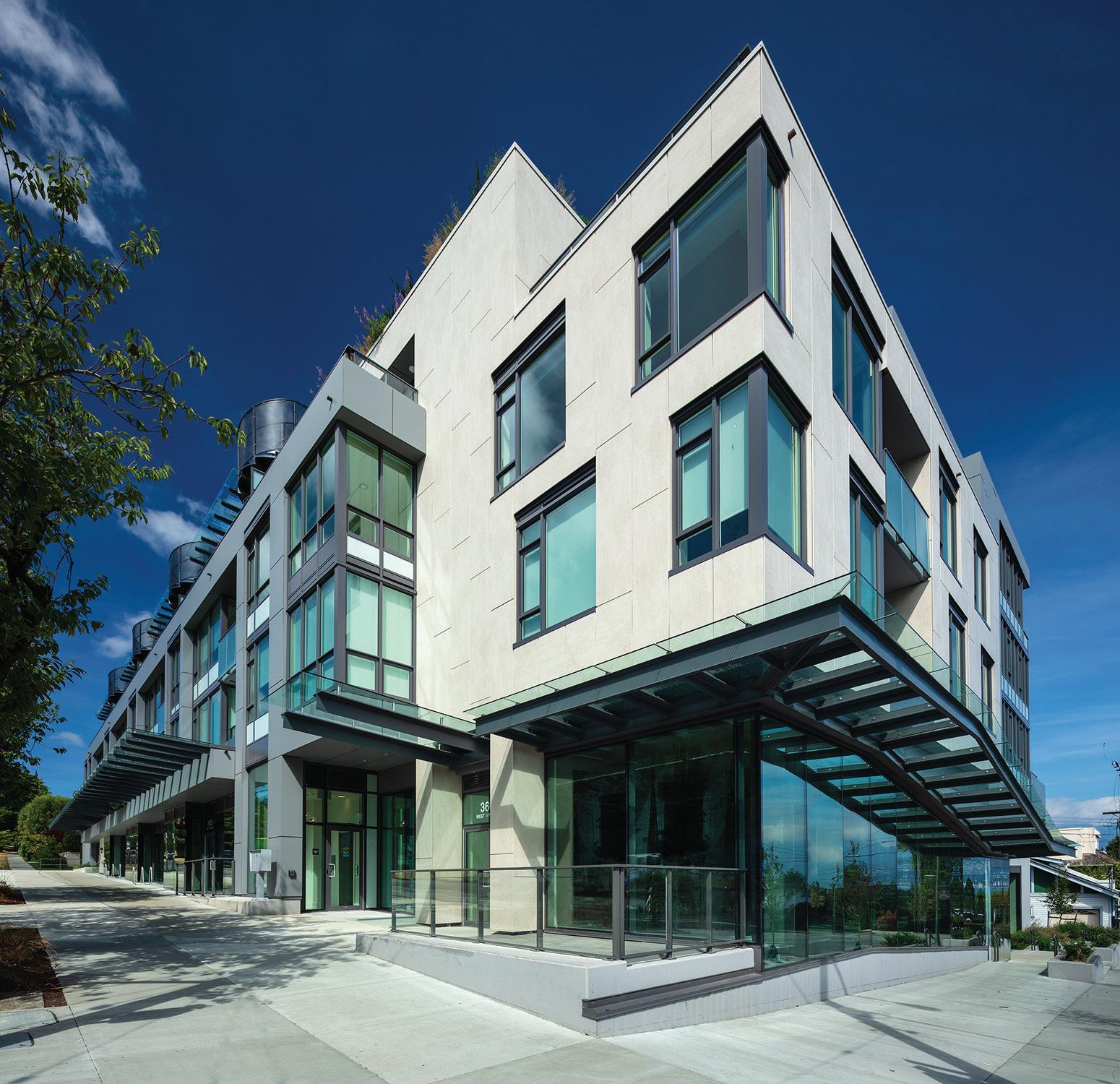
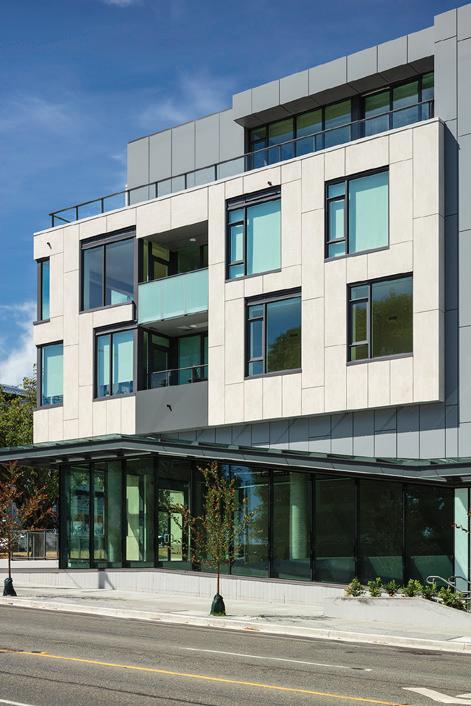
 Installer: Keith Panel Systems
Installer: Keith Panel Systems
TOP Ini Adedapo, a University of Calgary M.Arch student, reports on architecture and potential at the CAFÉ West event in March 2020.
Kind Hart Women Singers contribute a song ceremony to the CAFÉ Prairie event in February 2020.

Jonathan Kabumbe and Noémie Lavigne lead a presentation in November 2019 at CAFÉ Québec.
DC: This month, we will publish our key findings and recommended ac tions. We’ll present these at the CACB Conference in Ottawa at the end of October 2022. The goal is to communicate the need for change and potential for the profession to rise to the challenge of self-transformation. We aim to garner further support for change within the architectural community, so this can be leveraged through advocacy for better policies at federal and regional levels. We will also publish a study of architecture policies in Europe, which can guide Canadian policy makers. Ultimately, governments write policy. Our group’s role has been to sketch policy pri orities, encourage architectural advocacy, and model the change we want to see at government levels. Our next steps will include building a collab orative platform for industry partners to work toward the changes we can make without government intervention.
LL: Following CAFÉ Capital, we further plan to publish a white paper towards equity in architectural education, to share best practices among academic and professional sectors, and to advocate for these priorities in institutional processes and policy.
What are the key recommended actions?
DC & LL: We call on the entire architectural profession to more boldly commit to addressing the climate crisis; to improving diversity, equity and inclusion in the profession, as well as accessibility in built environ ments; to meaningfully involving communities in the design process affecting them; to working in partnership with Indigenous peoples to advance the Calls to Action of the Truth and Reconciliation Commis sion of Canada; to expanding the definition of public interest; and to renewing governance and accountability among architectural regulators and advocates, professionals and educators. The challenges we face and the change we need require everyone working together architects, regulators, educators, students, advocacy bodies and allied professions.
How might the architecture community support these efforts?
DC & LL: Read our report. If you support its recommendations, write to your association and to the RAIC, and urge action toward influencing legislation. Write to your Members of Parliament, and encourage them to read the report and move an architecture policy forward. Above all, act within current mandates to effect positive change. We will be calling on all within the profession to move towards a renewed social contract.
DC: We would like to thank all the members of task force, the Advisory Group, all the professionals who shared feedback, as well the RAIC, the Regulatory Organizations of Architecture in Canada (ROAC), and the Canadian Council of University Schools of Architecture (CCUSA) for their support.



LL: Thanks also to everyone participating in CAFÉ , especially the stu dents who have assisted in the research and reporting, and the Social Sciences and Humanities Research Council of Canada (SSHRC)
Darryl Condon is managing principal of hcma architecture + design in Vancouver and Chair of the Rise for Architecture / ROAC future of architecture working group.
Lisa Landrum is a professor of architecture and associate dean at the University of Manitoba, CAFÉ project lead, and Rise for Architecture steering group member.
MIDDLE
 TEXT Jonathan Tinney
TEXT Jonathan Tinney
THIS SUMMER, ARCHITECTURE AND PLANNING FIRM SVN CONVENED A SERIES OF CONVERSATIONS WITH INDUSTRY THOUGHT-LEADERS ON DECARBONIZING OUR CITIES AMIDST THE CLIMATE CRISIS. HERE’S A REPORT ON ONE OF THOSE TALKS.
Over the last two decades, the building industry has been developing new ways of decreasing energy use and related carbon emissions in new build ings be it through the use of a range of rating systems or improved build ing codes such as BC’s Step Code but programs and policies to drive reductions in the existing building stock have proved more challenging.
In early 2022, the City of Montreal rolled out a new requirement for large, existing buildings to measure and disclose their fossil fuel usage on an annual basis. Tracking and disclosing energy usage will be followed by mandatory reduction targets. This comes on the heels of legislation implemented by the Province of Quebec that will prohibit new oil-based heating systems and limit new natural gas systems, beginning in 2024. These are bold moves, and so watching how these policies roll out in Montreal will be helpful for informing similar policies across the country.
I recently spoke with Philippe Dunsky, President of Dunsky Energy + Climate Advisors as part of SvN Architects & Planners’ LinkedIn Live Series – SvN Speaks. Based in Montreal, Dunsky brings over 30 years of experience supporting governments, utility companies, businesses, and non-profits across North America to accelerate the transition to clean energy through policies, strategies and investment decisions.

Dunsky’s firm played a key role in Montreal’s climate bylaws, first by mapping Montreal’s Greenhouse Gas (GHG) footprint, and then assessing reduction opportunities and costs. This initial work found that the Greater Montreal Area has the potential to realistically achieve 55-60% GHG reductions by 2030 and 100% or “net zero” emissions by 2050. The City of Montreal adopted those targets, and proceeded to develop a plan, with Dunsky’s support, to achieve them.
The plan’s focus on emissions from buildings is noteworthy. At a high level, owners must measure and disclose their buildings’ emissions to the
City by 2024, a reasonably simple requirement because measuring the fos sil fuels required to heat buildings doesn’t include measuring embodied carbon. The disclosure process begins with buildings over 15,000 square metres, followed by buildings above 5,000 square metres and 2,000 square metres in 2025 and 2026, respectively. After this initial “informa tion” period, mandatory GHG performance requirements take effect, starting in 2028, when the largest buildings have to satisfy the first level of mandatory emissions reductions.
As Dunsky noted, “What’s critical is that the emissions caps are going to be laid out in advance so that everyone knows where they need to be at each milestone leading up to 2040, when every building will have to be at net zero.”
What anticipated effects will Montreal’s energy performance and dis closure have on the building industry? Will the insurance or finance sec tors help or hinder market uptake? Dunsky explained that disclosure and performance criteria are both necessary for a workable plan, adding, “If the banks have a clear understanding of how standards evolve, they will require building owners to make sure their investments are not just nearterm or simply aesthetic but can achieve net zero to avoid future liability.”
Change is inevitable, but not all building owners will embrace it. Still, Dunsky believes the clarity of the message is essential: by setting a hard target of net zero emissions by 2040, building owners and the real estate community at-large know the end-game, and can plan ac cordingly. Furthermore, in leading by example the City of Montreal
ABOVE Phillippe Dunsky, president of Dunsky Energy + Climate Advis ors, was interviewed by SvN Architects + Planners partner Jonathan Tinney as part of a series of climate policy talks organized by SvN.


is requiring that its own buildings achieve net zero a full 10 years earli er, by 2030 “the city will make it a lot harder to say, ‘this is impossible or crazy.’” He also acknowledged a growing consensus on the need to act on climate change, with building owners and lenders increasingly stepping up, and many supporting strong regulations so that everyone can be on a level playing field.
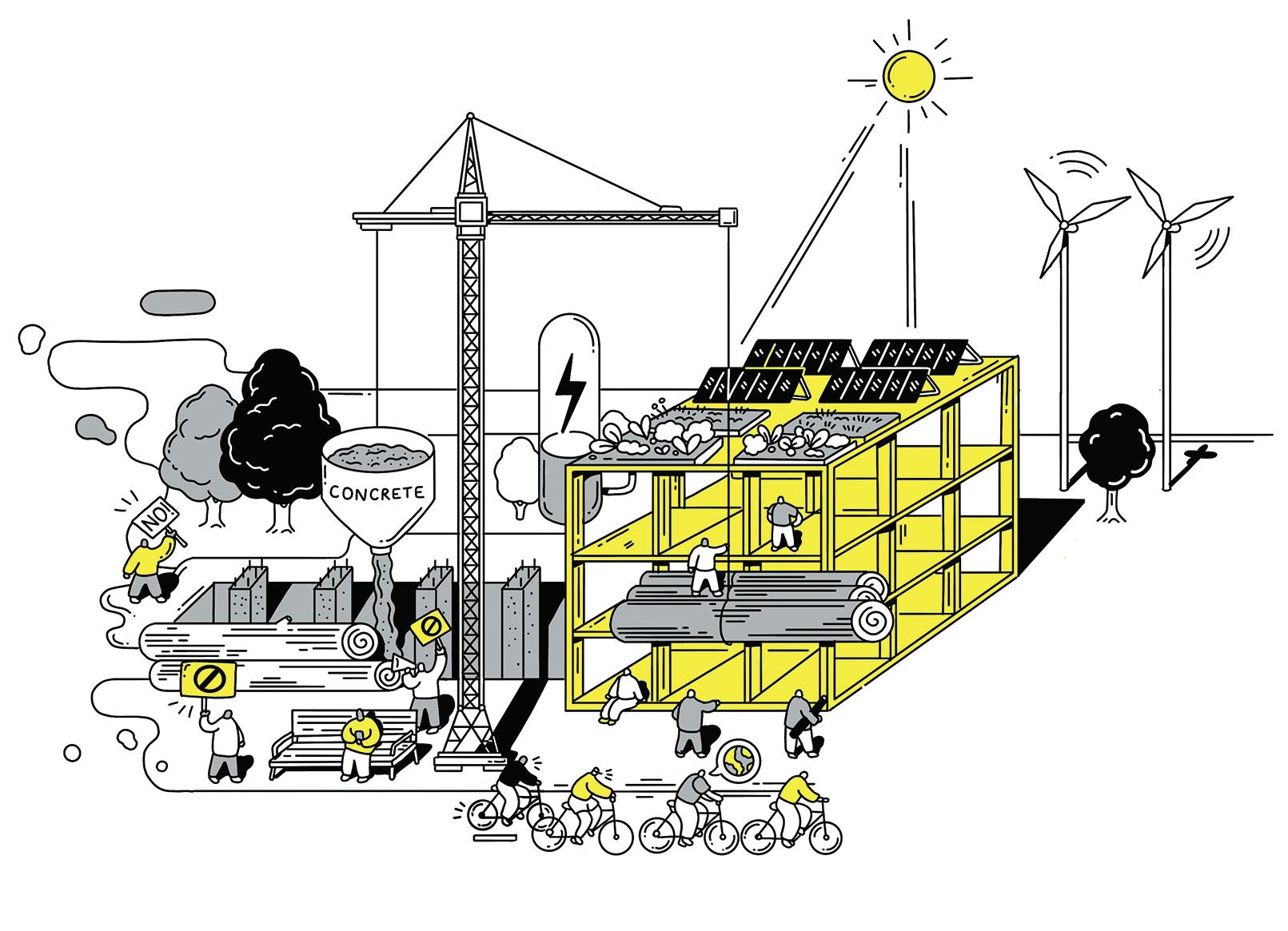
While the City of Montreal took the lead within the Greater Mont real Area to set net-zero targets, surrounding municipalities have yet to adopt similar measures. Could Montreal’s ambitious policies harm its economy? Dunsky believed that most stakeholders understand the inevitability of climate change, citing the gas utilities, who generally supported Montreal’s policies because they want to be part of the solu tion. Gas utilities are currently looking at renewable natural gas as a source of net-zero energy. He added, “Ultimately, the way to address the competitiveness issue between Montreal and the surrounding sub urbs is not to sit back and do nothing out of fear of a race to the bot tom. To the contrary, Montreal is saying ‘We need a race to the top.’ Already, their approach has been applauded by the Province, and will likely inspire similarly ambitious moves throughout the province.”
Outside Quebec, the City of Toronto announced a similar intent to Montreal’s net-zero policies. In May 2022, the City of Vancouver an nounced a similar policy to Montreal’s, setting 2040 net-zero targets for large commercial and institutional buildings. With Toronto, Mont real and Vancouver going in the right direction, setting stricter carbon budgets begins to feel normal. Another important precedent is the BC Energy Step Code, an optional compliance path in the BC Building Code that local governments can use to incentivize or require a level of energy efficiency in new construction that exceeds the requirements of the BC Building Code. Builders may voluntarily use the BC Energy Step Code as a new compliance path for meeting the energy-efficiency requirements of the BC Building Code. The Step Code continues to influence other provinces like Nova Scotia or the federal government as it works to revise its National Building Code.
As we move to decarbonize our buildings, the proliferation of glassy, gas-heated condominium developments appears increasingly out of step with our cities’ desire to achieve net zero. But as Dunsky pointed out, the City of Montreal has the authority to regulate GHG emissions, not energy efficiency. A condo building that uses natural gas as a central ized system will have to have it replaced, while upgrades to building
GHG EMISSIONS


inventory of Montreal's building stock—and its contributions
greenhouse gas emissions—was a first step in setting netzero
city.
envelopes are outside the purview of the current regulation. Interesting ly, Vancouver plans to move beyond GHG emissions and include energy efficiencies as part of its thermal intensity requirements by 2040.
Will setting net-zero targets create disincentives to improve existing buildings, possibly resulting in the unintended consequences of replacing rather than retrofitting a building? Because Montreal focuses on energy systems rather than building envelopes, changing a natural gas system to either a renewable natural gas system or heat pumps is not cost-pro hibitive. As for creating incentives, Dunsky noted examples of policies encouraging compliance with decarbonizing regulations. He cited the Canada Infrastructure Bank’s Building Retrofits Initiative, which Dun sky designed. Part of its Green Infrastructure support programs made $2 billion available to provide low-cost financing to help de-risk major building retrofits focused on decreasing emissions. Under its terms building owners won’t see a cheque from the government: instead, their banks would offer a lower-interest loan for green developments commit ted to lowering a building’s carbon footprint than for standard projects.
Our current policies need to include embodied carbon in our build ings, not just energy use. Dunsky acknowledged that we could get there, but we first need to address the issue of direct GHG emissions. Once a set of commonly accepted rules for measuring carbon is achieved, we can then standardize voluntary incentive programs, fol lowed by effective regulatory approaches. There is room for evolution and growth when defining standards for carbon budgets of new and existing buildings. “I’m a big believer of the 80-20 rule. Get the big stuff done now, and leave the rest as a next step,” Dunsky added.
As we continue to evolve net-zero strategies, the need to implement practical and implementable policies to decarbonize our buildings has never been more urgent.
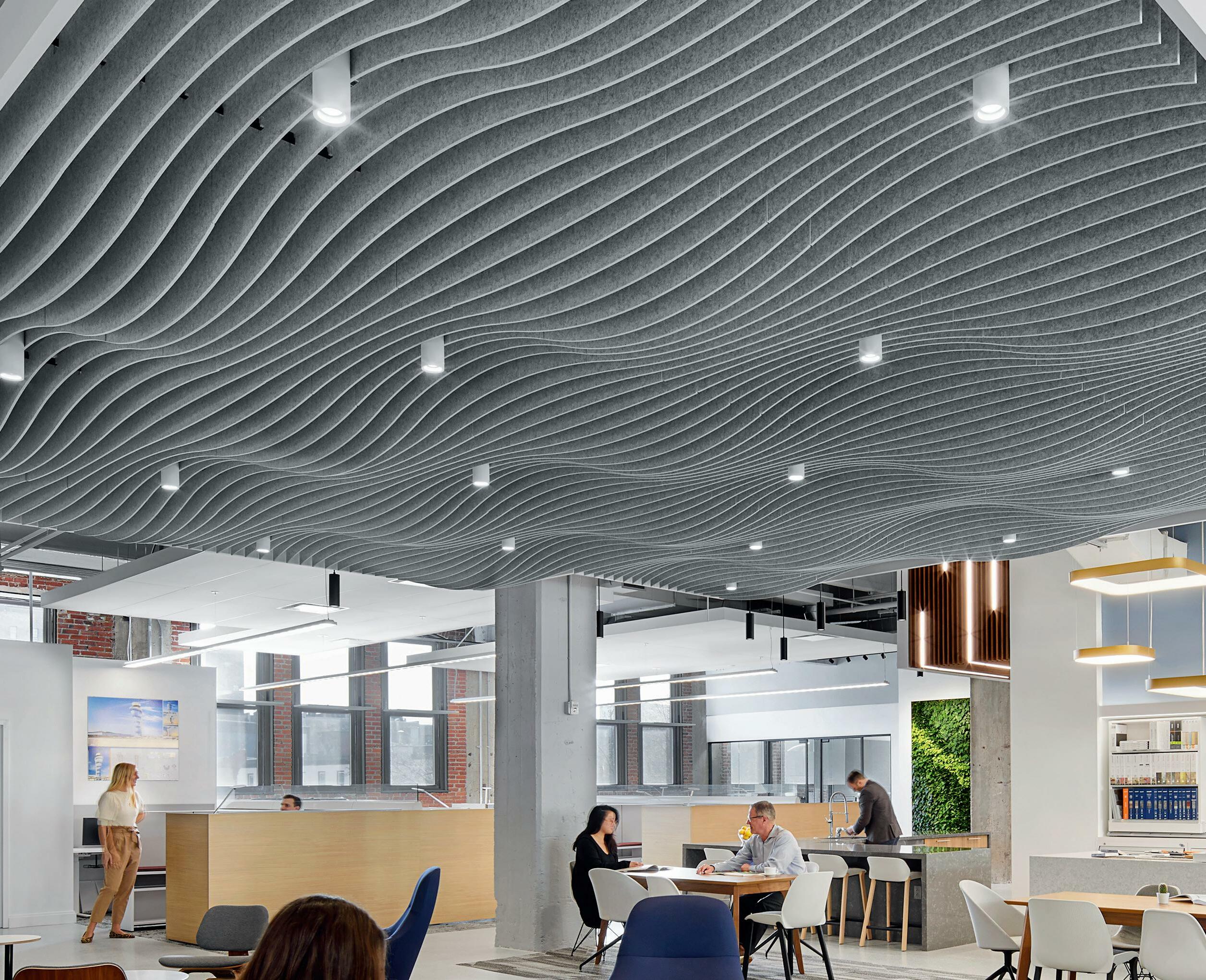
Jonathan Tinney is an urban planner and partner of SvN Architects + Planners.

on each of the five talks in the SvN Speaks series can be found at canadianarchitect.com, and the talks can be viewed
entirety




























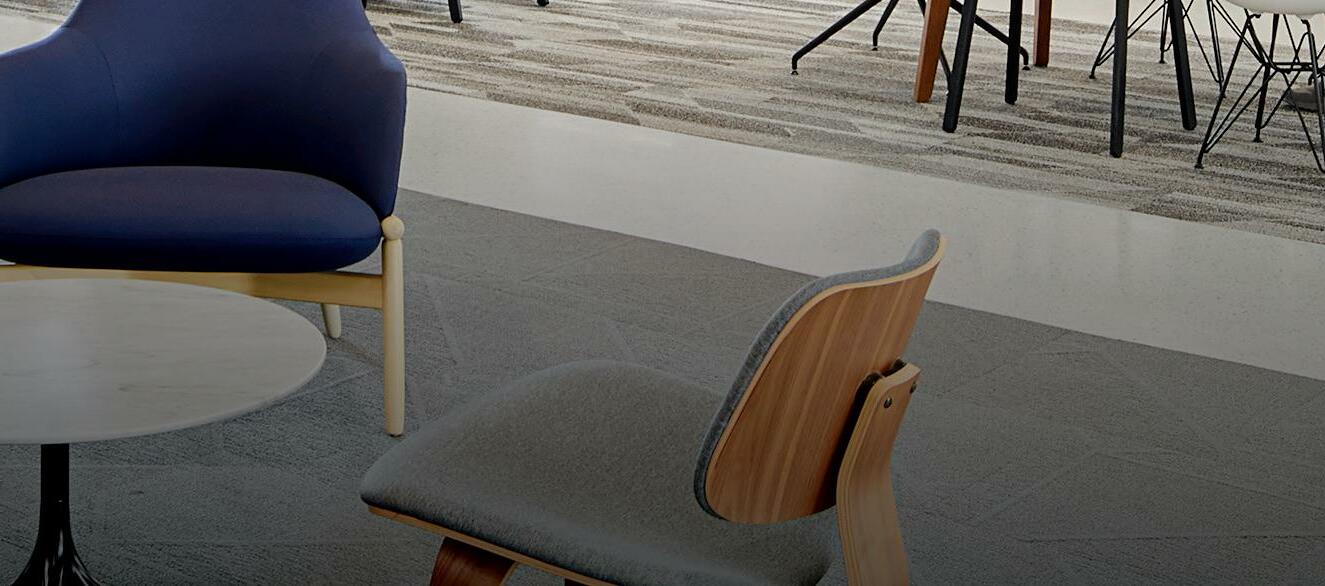

FeltWorks® Blades can help you create understated interiors with soothing movement and subtle color – or dramatic pops of color, shape, and direction. Transform mundane to modern and absorb sound with a soft visual texture. Both standard and custom panels are part of the Sustain® portfolio – meeting the most stringent industry sustainability compliance standards today. Learn more about tranquil sophistication at armstrongceilings.com/feltworks
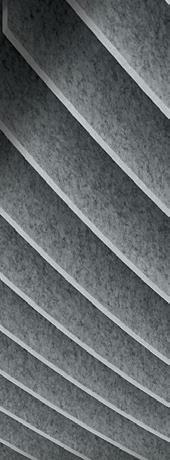



 FELTWORKS ® BLADES EBBS & FLOWS KITS / THE SHEWARD PARTNERSHIP OFFICE, PHILADELPHIA, PA
FELTWORKS ® BLADES EBBS & FLOWS KITS / THE SHEWARD PARTNERSHIP OFFICE, PHILADELPHIA, PA
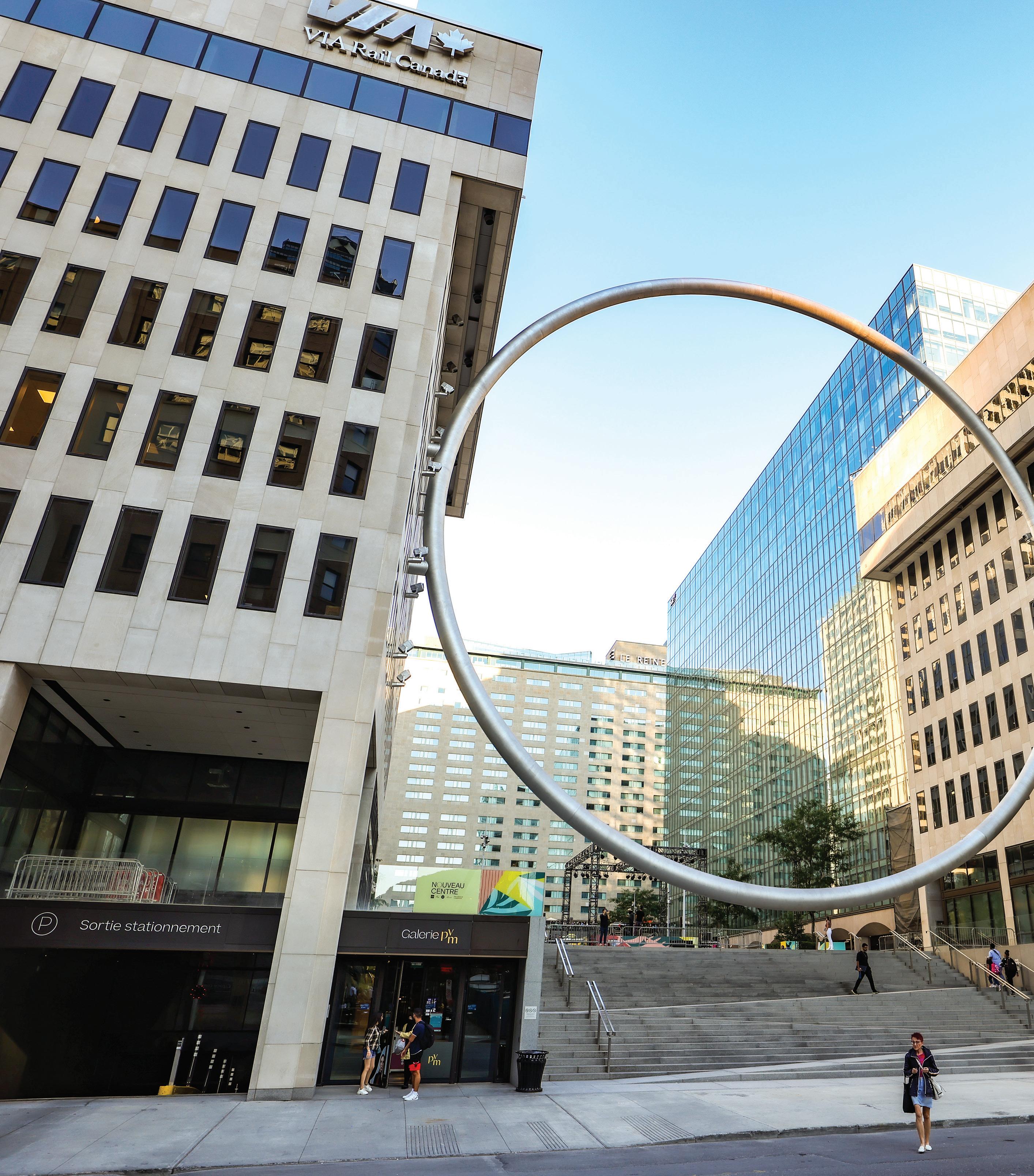
When Place Ville Marie opened in downtown Montreal in 1962, the design, by Henry Cobb working with I.M. Pei, included an elevated grand plaza, bookended by equally grand staircases. One of those stairs facing McGill Avenue and leading to the gates of McGill Uni versity was displaced, for over 50 years, by an entrance to the com plex’s underground parking.
In 2018, the current owner, Ivanhoe Cambridge, set out to revitalize the raised esplanade, working with Sid Lee Architecture to add massive skylights connecting the plaza to the restaurant spaces below, and restor ing the north staircase as it had been originally designed. To cap off the $200-million project, the owner asked local landscape architecture firm Claude Cormier et associés to create an installation that would com plete the space above the new grand stair.
“We came up with the idea quite easily,” recalls Claude Cormier. His team wanted to reference the modernist grid of Cobb’s design, but offer a fresh take on it. A circular ring was the perfect fit for the space, fitting snugly in the 30-metre-wide opening, while providing enough clearance below for pedestrians to walk under it easily.
The Ring frames some 200 years of history, says Cormier. “At the end of the axis, we have McGill University, founded in 1821; in the back, we have Olmsted’s Mount Royal Park, from 1874, with the white cross, put up in 1950 to commemorate Maisonneuve, the founder of Montreal.”
The preservation of the visual axis along Avenue McGill College also encompasses a more recent history, says Cormier. In 1984, Phyllis
LEFT The 30-metre-diameter stainless steel ring fits snugly between Place Ville Marie's north buildings and is suspended above a new grand staircase to the elevated plaza.

Lambert blocked a large mixed-use complex from being constructed in front of Place Ville Marie, he says. “She fought her own brother [the developer] to create this iconic moment in downtown Montreal.”
“For me, that’s what building a city is about one thing after another, they all work together in resonance. Phyllis Lambert had a vision in her mind of something that was bigger,” says Cormier. “The Ring is trying to showcase that all together.”



The artistic installation also looks towards the future. The city’s cen tral train station is nearby, and the Ring sits atop the location where a new set of underground municipal rail tracks will enter the station. Following the construction, Avenue McGill College will be recon structed as a forest-like linear park designed by civiliti + Mandaworks and SNC-Lavalin.
To create the Ring, the design needed to respond to many constraints, including minimizing impact to the newly renovated heritage towers. To achieve this, the team engaged NCK’s Franz Knoll the structural engineer that had worked on the original Place Ville Marie, as well as landmarks including the Louvre Pyramid. Knoll devised a solution that touches the towers in just four places, pinching the building’s structure at its strongest points to support the 23,000-kilogram Ring.
Knoll also advised on the structure of the Ring itself, which takes shape as a self-supporting stainless steel cylinder, with 9.5 mm-thick walls on top and bottom, and 16 mm-thick walls at the sides. It was created in six segments, with connecting flanges hidden behind ac cess doors. Inside the cylinder, 1,800 linear metres of heating cables
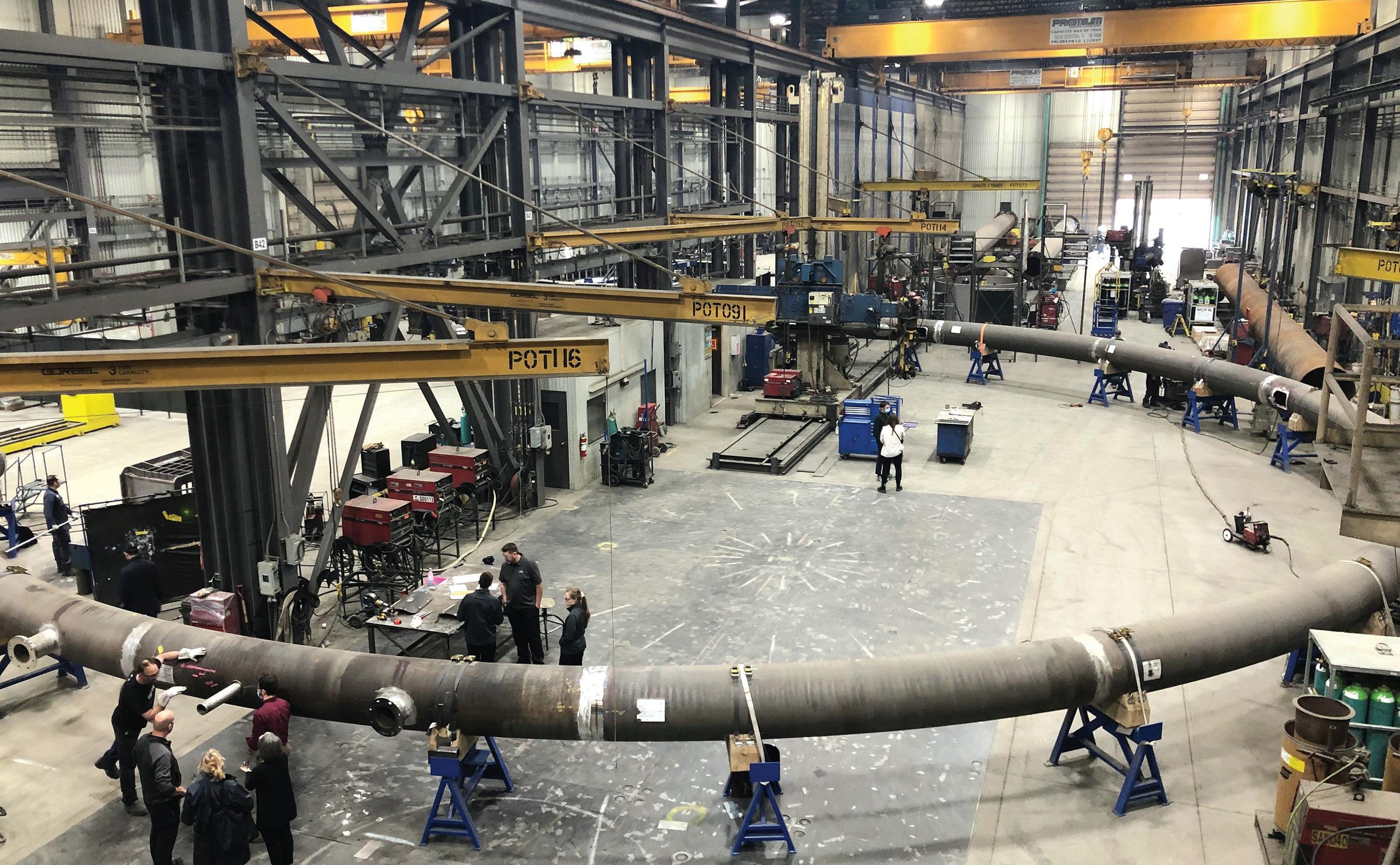



The patented TcLip™ is a key component of the holistic SYSTEM2 approach. Used alone, or together with our SYSTEM2 approach, the TcLip™ helps achieve the thermal performance required by various building codes in North America.

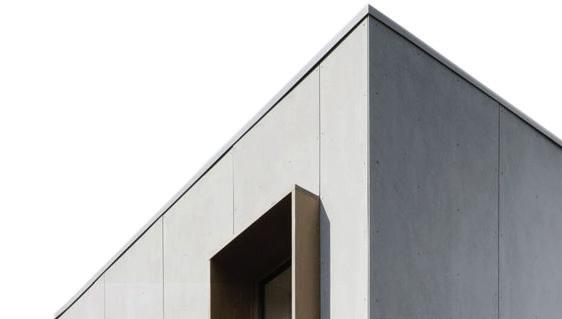



ABOVE The Ring frames a vista through Montreal's past history, and also considers the future transformation of the site through the competi tion-winning concept design for “McGill College: Reinventing the Avenue,” developed by civiliti + Mandaworks with SNC-Lavalin for the Ville de Montréal. RIGHT The 23,000-kilogram ring is suspended from four points on the recently restored buildings.

assure that the installation will resist ice and snow accumulation. The 1-millimetre joints of the structure are virtually invisible, giving the resulting design the appearance of a pure, single form.
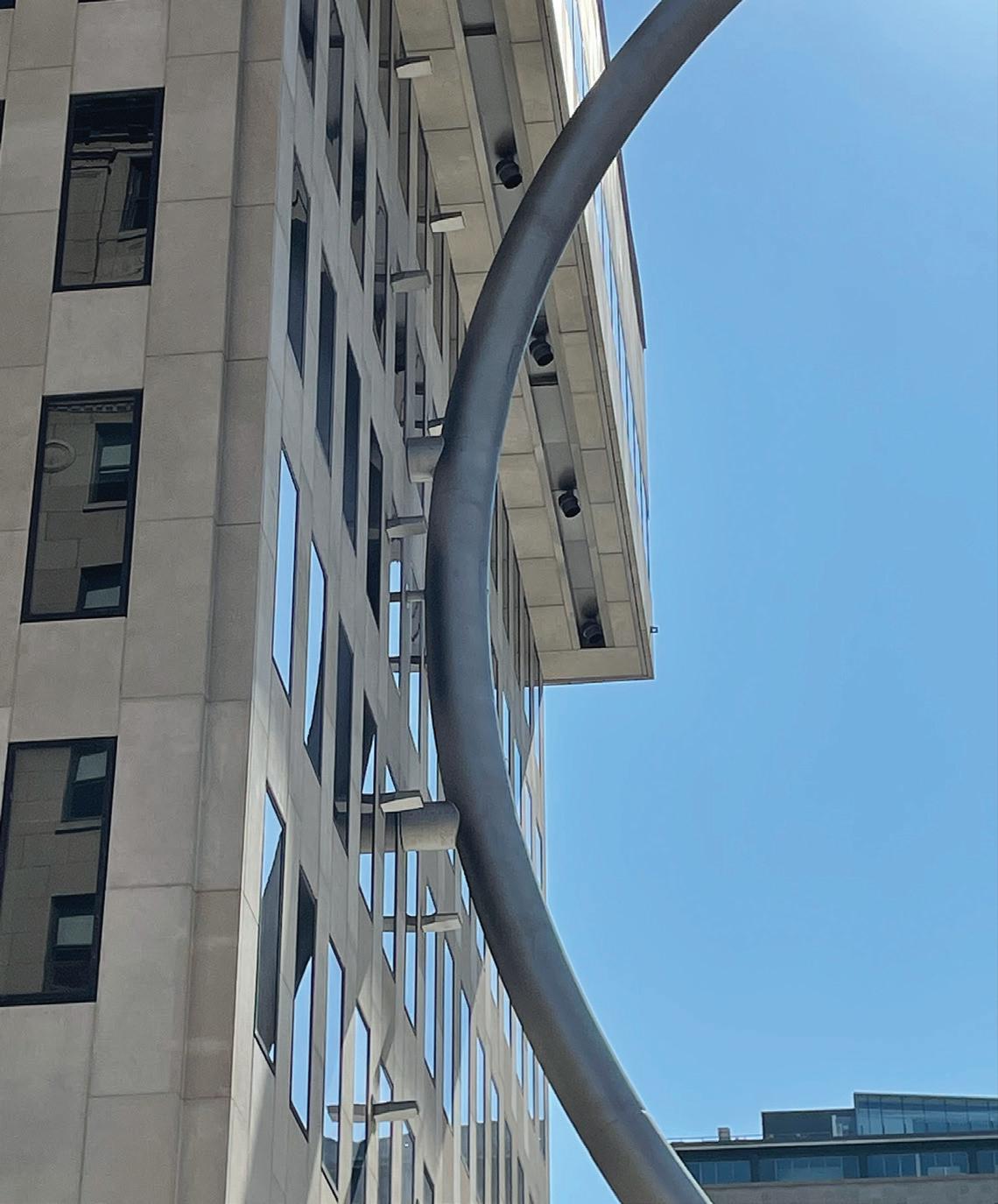



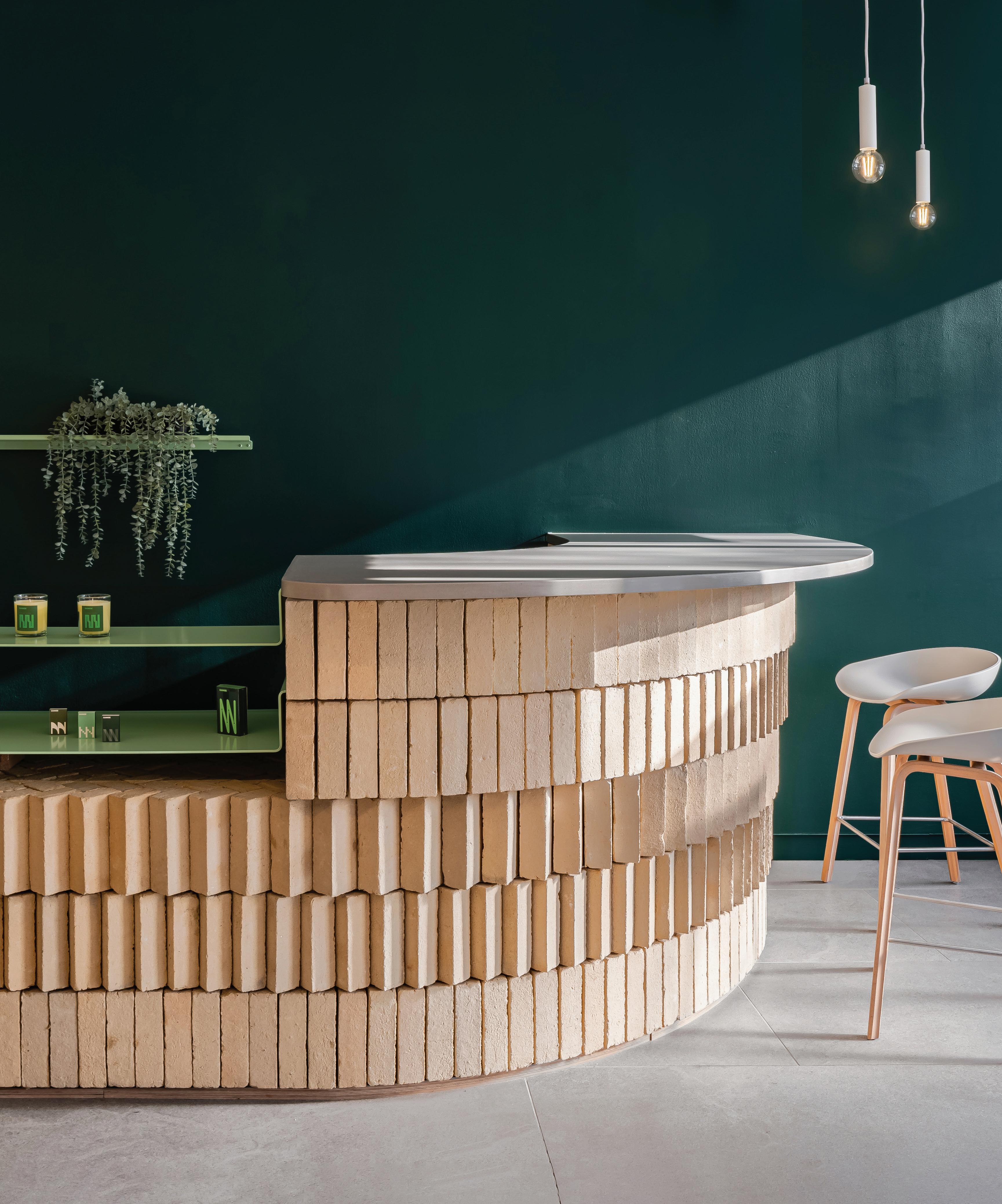
The project “has created a love interest in the media since it was un veiled,” says Cormier. But not all of that attention has been positive its $5-million price tag has also been the subject of hot debate.
“Some people were really offended by this, doing something with no purpose,” says Cormier. But he says that while the Ring may not be strict ly functional, it does indeed have purpose: “It creates identity, a notion of place, taking care of our city, investing in our city,” he says. “We were busy enough in making it work, but we had the feeling it was right.”



Turning off Keele Street, just minutes north from the commotion of Toronto’s busy Highway 401, the city retreats. It is quiet, calm. The expansive grass fields and unobstructed sky views of the former Downsview Airport are a fitting landscape for a new aviation hub.
Centennial College’s facility for Aviation and Engineering Tech nology & Applied Science, designed by MJMA and Stantec with ERA as Heritage Architects, is an adaptive reuse project situated within the geographic heart of Canadian aviation history. The school proudly occupies one of the most significant of several sprawling air craft buildings that flank the lengthy Downsview runway. The his toric de Havilland of Canada building is the oldest surviving aircraft factory in Canada; it’s where nearly 3,000 Tiger Moth aircraft and some 1,134 Mosquito bombers were built; where the company developed the Twin Otter and Dash-8; and where the first Canadian satellite, Alouette I, was assembled. After the plant’s closure, the hangar was used by CFB Toronto, and later served as an air and space museum before being mothballed in 2011.
By the time Centennial College acquired the facility, the 1929 build ing had preserved its additions from 1937, 1939, 1940, and 1944, but was
LEFT A glass-box hangar was added to the adaptively reused de Havil land building, allowing modern aircraft with larger wingspans to be used as teaching aids for aviation technicians-in-training.
slowly falling into disrepair. Through selective demolition and addition, the designers undertook the challenge of uniting the complex, while respecting its original fabric and rich history. Today, it welcomes a new generation of aviation technicians-in-training.
A glass overhang stretches along the property’s entrance off Carl Hall Road. This element frames the restored masonry of the 1939 and 1940 façades and builds on a tradition of bold civic entrances. Canti levered at either end, the canopy refers to an acrobatic aeroplane wing. A wall adorned with historic images creates an exterior public gallery, and the backdrop to an appealing barrier-free ramp. This welcoming gesture one of just a few bold architectural moves within the project sets the tone of the design as a strategic refurbishment, which takes its cues from the history of the building.

“The site had a clear story to tell,” says MJMA principal Robert Allen, explaining that the ambition of the team was to reveal that story as clearly as possible. Stephen Philips, senior vice president at Stantec, adds that “patience, patience, patience” was key to achieving this goal. The two firms worked closely together to develop an architectural strategy that preserved and made highest use of the building’s existing fabric, including its large open spaces.

Today’s LEDs may last up to 50,000 hours, but then again, Kalwall will be harvesting sunlight into museum-quality daylighting™ without using any energy for a lot longer than that. The fact that it also filters out most UV and IR wavelengths, while insulating more like a wall than a window, is just a nice bonus.
 photo: Scott Norsworthy
photo: Scott Norsworthy
One such space is a former double-height warehouse area, which has become the Student Commons, just inside the main entrance. Here, varied aspects of student life converge with informal gathering areas, food vendors, and study rooms. Tall ceilings and clerestory windows contribute to a sense of openness, despite a compact layout. Imprinted into the terrazzo floor of the Commons is an oversized windrose a reminder of how the site’s unique wind patterns shaped the airport’s runway configuration, along with the de Havilland building’s placement and orientation.

The Commons is surrounded by program on all sides, including a two-storey glass partition that looks into the building’s most dra matic space a cathedral-like, 2,600-square-metre hangar, complete with a 28-meter-wide bridge crane capable of lifting 3,000 kg. In this case, new construction was necessary, as the historic hangars were too small to accommodate the wingspans of the commercial aircraft that students are learning to service. Like the grace of a heavy aircraft taking off, the hangar appears to hover effortlessly above its concrete
floor. An ambitious structural design leaves its glass enclosure appearing weightless. Despite the hangar’s program as a functional classroom, it has been conceived with thought and care replace the Cessna Cita tion II commuter jet and Bell 206 helicopter with Richard Serra sculptures, and it could easily be the showstopping atrium of a con temporary art gallery.
An equal thoughtfulness is evident through the project. The team from MJMA, Stantec, and ERA was careful to balance between nar rating the building’s historic significance while creating architecture for daily use: after all, the building is now a teaching facility, not an aviation museum. Throughout the facility, glazed interior partitions connect common areas and circulation zones with meeting rooms, classrooms, and labs. This allows the structural bones of the heritage architecture to enjoy a continuous presence throughout, while also putting the contemporary teaching artifacts on display, including im pressively ornate, elephant-sized engines. Existing walls were stripped to reveal restored masonry, while new walls were embellished with


aeronautics-themed infographics. Fittingly, the building’s high-performing mechanical systems are exposed throughout.

Following an old aviation tradition, the building’s green roof bears the name of the College today visible by pilots and passengers, as well as Google map viewers. Classrooms at the building’s centre are given sky views through clerestory windows. While several of the lab spaces are double-height, the 1939 portion of the building is topped by a second level, housing additional classrooms and computer labs. In the upper storey space, an informal study zone overlooks the Stu dent Commons below, while a glass-enclosed boardroom also enjoys views over the two teaching hangars its sightlines similar to those of an air traffic control tower.
MJMA , Stantec, and ERA have brilliantly brought themes out of the existing elements, while skillfully adding their own mark. The result is thoughtfully executed architecture that reads lightly. Centen nial College's Centre for Aerospace and Aviation at Downsview inspires a new generation of aviation experts while demonstrating that, for architects embarking on adaptive reuse projects, the sky is the limit.
Aidan Mitchelmore is a Toronto-based Intern Architect who has a passion for architec ture and public buildings.
ABOVE The secondary hangar, now used as a teaching area, is a repur posed hangar from the 1940 portion of the building. The original bridge crane is still used to move helicopters and small aircraft within the space. OPPOSITE In a nod to an old aviation tradition, the building's green roof bears the name of the College.


Something big is happening east of downtown Toronto. The Don River runs through one of Toronto’s major ravine systems, and is one of the most urbanized watersheds in North America. In the largest design and construction project of its kind currently underway in North America, crews are restoring the natural systems of the mouth of the Don River, where it empties out into Lake Ontario. The river, in its current con figuration, is being moved.
It’s a monumental effort to carve a new river channel out of the exist ing industrial lands. This entails dismantling buildings, remediating soils, layering new habitat on top, and setting the stage for future develop

ment. This de-engineers over a century of development, and will ultim ately recover the site’s deep ecological history as a dynamic estuary: the mouth of the Don River was once the largest freshwater wetland on the Great Lakes. But people are also a big part of the picture: the result will include large-scale urban parks, as well as an urban neigh bourhood embedded in nature.
A landscape architecture firm as opposed to an engineering firm is leading the overall master planning and design efforts for this pro ject. This meant that the design process for Villiers Island, as the landform defined by the re-directed river will be known, began with
ABOVE To imitate natural ecosystems, where trees are sometimes stranded in rivers and streams, a series of large, dead trees are anchored in the riverbed. Snags provide critical shelter and spawning sites for fish, as well as a set of surfaces where biofilms can form, supporting other aquatic invertebrates. OPPOSITE Designed to provide green infrastructure for migrating birds, the landscape includes an island at the south end of the site that is inaccessible to people. Although yet incomplete, these areas are already starting to attract swallows and waterfowl. But nesting birds can engender a stop to construction activity, so the crew includes a falconer, whose bird and dog are trained to drive away wildlife without harming it.
a close examination of the area’s ecology. Michael Van Valkenburgh and Associates (MVVA), the winner of a design competition for the masterplan in 2008, asked: How could the infrastructure of the river bed become the foundation for place-making in this part of Toronto?
By considering the larger hydrological network and reconnecting to the Don River Ravine system, the scheme also designs for resiliency in the context of climate change.

The design strategy takes its form from the morphology of the Don River, rather than from colonial urban grid laid down by John Graves Simcoe in the late 1700s, or the Keating Channel that redirected the Don through a sharp 90-degree turn in 1893. A single, complex parkland is used to naturalize the mouth of the Don River, provide a floodway for storm events, and allow for recreational uses. Rather than attempting to restore back the site to a pre-settler “pastoral” condition, MVVA’s design for Villiers Island takes a more layered approach which reveals the site’s previous uses, including its industrial regimes, creating references between the restored ecologies, the river, and the City of Toronto itself.
Dating back to prehistoric times, Toronto was a meeting place for First Nations, and Ashbridges Bay was a fertile fishing and hunting ground. The site’s history as an Indigenous cultural landscape added another layer to the design. MVVA has integrated Indigenous profes sionals into the design team, and Waterfront Toronto has established a Memorandum of Understanding with the Mississaugas of the Credit First Nation, which holds Treaty 13 with Toronto, moving their role towards partnership rather than simply consultation. This input has helped to inform the project, which for Indigenous stakeholders rep resents an important healing of the land and re-engagement with the river, providing renewed access to the water. The design of the area’s interconnected green spaces also support Indigenous-led program ming: an event lawn includes a lookout and spaces for pow wows along the river, fire pits allow for ceremony, and gathering areas invite sunrise gatherings. The planting palette is also informed by Indigenous knowledge, with species chosen for their cultural and ecological import ance to the pre-settler landscape.


The design is also attuned to the needs of local animal species. In the future Promontory Park, a restored wetland is already attracting local wildlife. Colourful flags have been strung up to protect the growing fish population from predatory birds until it is fully established. In other parts of the site, new sandy riverbanks are attractive to swallows: the ecological restoration team includes a trained falconer, who is charged with keeping the birds away until the landscape is completed if they become estab lished, nesting birds could mean a stop to construction.
Much of the design is geared towards protecting new development, as well as adjacent neighbourhoods, from flooding but in a way that works with nature, rather than against it. In 1954, Hurricane Hazel brought 110-kilometre-per-hour winds and dropped 285 millimetres of rain on Toronto in 48 hours, resulting in widespread flooding that was exacerbated by the artificial mouth of the Don River. The new river valley in the Port Lands is designed to mitigate similar events: the river is set in a 30-metre-wide floodplain, with wetlands lining the river to act like a sponge, and a new channel helping to draw floodwaters out, conveying them to Lake Ontario. Nature trails allow the wetlands to be enjoyed during drier times; these trails would not be accessible during a flood event. More permanent programming is located at the top of the bank, including parks, picnic areas, and play structures.

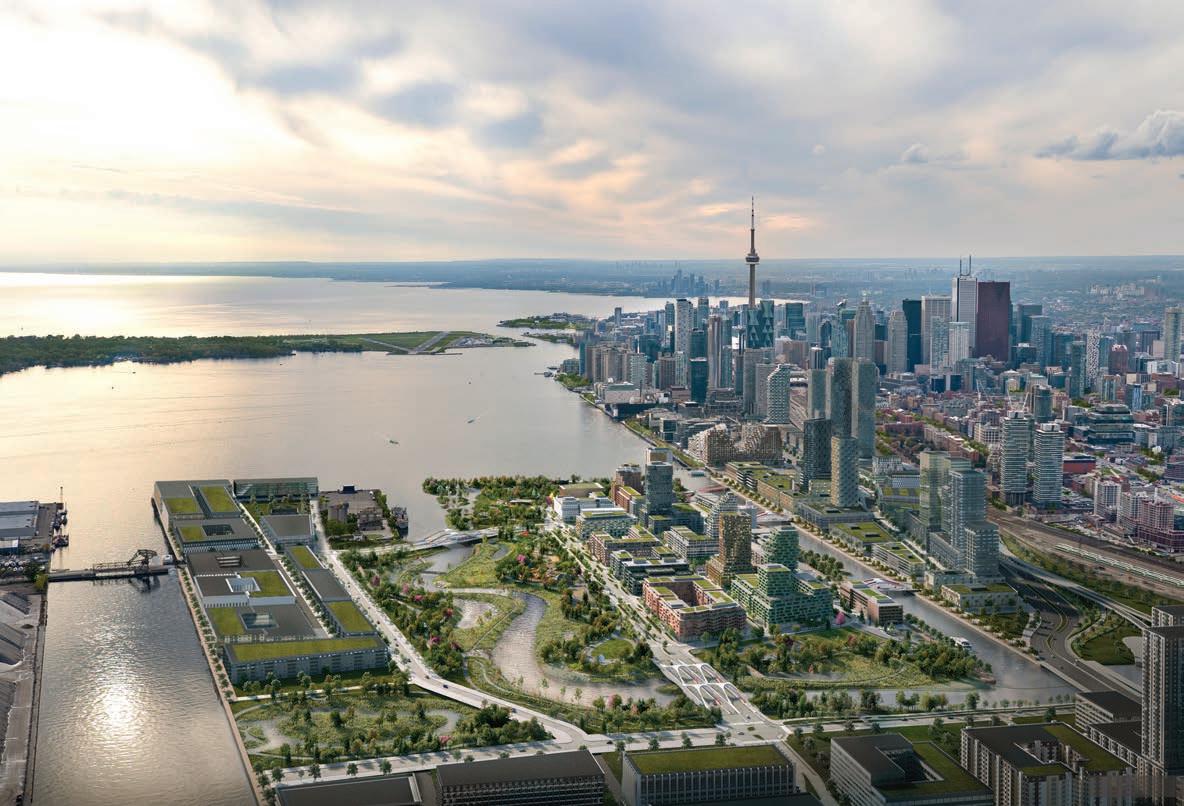

OPPOSITE In River Valley Park, an existing historic firehall has been relocated outside the floodplain and set back, to be repurposed as an amenity space for the neighbourhood. ABOVE Four new bridges for the site include a paired set that will house a roadway and future streetcar line for the realigned Cherry Street. The bridges were fabricated in Halifax and floated up the St. Lawrence Seaway, then set into place over the future waterways.
Toronto-based Urban Strategies led the development of the Villiers Island masterplan, which is currently being updated by O2 Planning & Design. Over the next several years, RFPs will be going out to develop ers, who will in turn be hiring architects to design the individual parcels.
All new development in the Portlands will follow design guidelines crafted by the City of Toronto in partnership with Waterfront Toronto. These guidelines will includes requirement for green infrastructure in all new developments, such as green roofs that will assist in Villiers Island’s role as an important flyway for North American bird migrations.
The urban plan also integrates innovation in its urban massing: the planned mid-rises maintain view corridors and gradually increase in height from south to north, giving the buildings greater access to sun light. MVVA’s initial design proposal included the managing and con veying of stormwater flows from buildings through the streets into the parks, but this was not permitted under current city guidelines. A dis trict energy plant is in the works for the Island as part of a 30-year plan.
The area will be home to some 10,000 residents, living in 5,000 resi dential units; schools and some 3,000 employment opportunities are also envisaged for the Island. Alternative mobilities are also part of the
plans: the area is close to the East Harbour GO Train station and the new Ontario Rapid Transit Line, currently being built. The Toronto Waterfront Business Improvement Area is actively campaigning for funding to implement a light rail transit line that will traverse the area.
Villiers' streets will include integrated pedestrian and bike systems; its waterways will invite boating a shared kayak system is in the works. Four new bridges were added to the site, designed by Entuitive, Grimshaw Architects, and SBP one of these, the Cherry Street North Bridge, is designated for a future transit line into the Port Lands. In several cases, the bridges currently span dry land, making the con struction of supports easier. As a final step when the landscape is com pleted, plugs at the ends of the new waterway will be removed, allowing the river to be filled.

Introducing a naturalized river mouth, the plan for Villiers Island stands in contrast to the willful engineering of the Keating Channel, which forced the Don River into a right-angle turn towards Lake Ontario. The island also resists the existing Simcoe street grid to instead develop topography-sensitive diagonal elements and through-block pedestrian

OPPOSITE Plantings for the future string of parks and wetlands include some 5,000 trees, 77,000 shrubs, and over two million herbaceous plants. During construction, a worker discovered local wetland plants growing in the construction area: further investigation revealed that they were from seeds bur ied over a century ago, when the original estuary was infilled for industrial development. The seedlings were recovered, and are currently being propa gated in a University Toronto facility. Researchers are also scouring the soil for more seeds to help restore the plants that were originally found at the site. ABOVE Because of the layered natural and industrial histories of the area, the project has entailed carefully tracking and moving over 1.4 million cubic metres of earth—an amount equivalent to the volume of the Rogers Centre. The project is anticipated to be completed in 2024.
connections. It is itself an act of engineering, even more intense than the original redirection of the Don: a $1.25-billion effort, funded equally by all three levels of government, that has involved moving 1.4 million cubic metres of soil, roughly the volume of the Rogers Centre. The new river bed and wetlands are set into place, rather than being open to changes over time, and fully lined to prevent groundwater contamination.

But rather than confronting nature, the landscape and urban design takes its cues from and even strives to enhance its ecological and en vironmental setting. It suggests how Canadian cities can be more sensi tive to the topography of places and landscapes that were long stew arded by First Nations.
There is still more work to be done. It will be crucial to leverage the new development in order to advance equity, particularly in the face of Toronto’s housing shortage. This would include a targeted percentage of subsidized affordable housing units, as well as incentives for artists' live-work studios, to maintain the historic presence of artists in the Port Lands from when it was an industrial zone. At the building and architec tural scale, it will be instructive to push for architectural solutions which
key into the larger site and ecological recoveries. How can the next itera tion of the masterplan implementation, as well as the residential and mixed-use typologies, integrate relationships to larger ecological and hydrological systems? In addition to the already mandated green roofs, this might further include living walls, green infrastructure and other low-impact design strategies at the lot, block and neighbourhood scale.
As we move towards the increasingly dire need to design our coastal cities for resiliency, Villiers Island will serve as a best-case practice model. The project will usher in the next generation of sustainable waterfront developments, defining new relationships between nature and city, human and non-human, and the restoration of original Indigenous landscapes. It will help us reimagine and rebuild our cities, with green infrastructure and resilient communities at their heart.
Shannon Bassett is Canadian-American architectural and urban designer, and an assistant professor at Laurentian University’s McEwen School of Architecture, where she teaches architecture and urban design. She holds a Masters of Architecture in Urban Design from the Harvard Graduate School of Design.
There’s a lane in Sundance Housing Co-op that provides a perfect “ before” and “after” picture for housing in Canada. On one side are the original townhouses, clad in 44-year-old tan stucco and brown sid ing. Across from them sit their freshly updated siblings, transformed with colourful new fibre-cement siding, new windows, and air source heat pumps outside. The old gas-heated buildings use about the same amount of energy as typical Canadian townhouses. The new ones use one quarter of that, all electric, and soon to be all-renewable. And they do it at a fraction of the cost and the emissions of a new build.
The retrofit of Edmonton’s Sundance Housing Co-op is a $7 million upgrade to the 59-unit, 15-building townhouse complex. The project is funded in part by Natural Resources Canada’s Green Infrastructure Phase II, Energy Efficient Buildings Program. Built in 1977, the Sun
ABOVE Edmonton's Sundance Housing Co-op was precision-scanned and outfitted with a new panellized envelope, dramatically improving its energy performance.
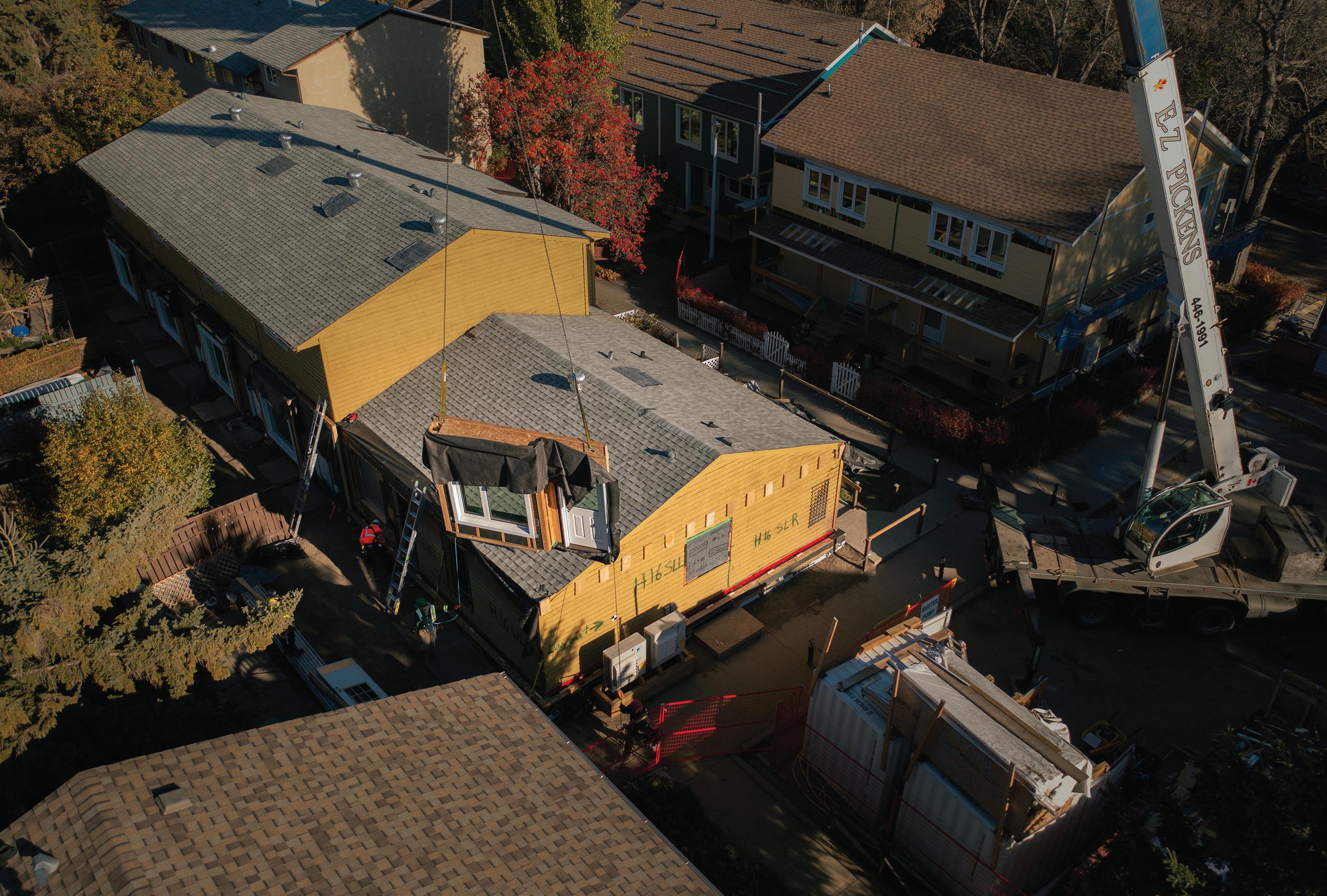
dance Co-op had been well maintained; but, beyond replacing windows in 1998, it had not had major interventions until now. The Sundance membership has a history of foresight. When the development was being built, they decided to forego closet doors to pay for the upgrade to 2x6 walls exceeding the building code. Forty years later, they knew re-clad ding was imminent, and realized that if they ever wanted the buildings to be net zero, it was now or never. The combination of decent structural condition, necessary exterior maintenance, and forward-looking collectiveminded ownership made Sundance a good candidate for a deep retrofit.
When our net zero design-build firm, Butterwick Projects, was approached with this project, we suggested that a panellized retrofit process had the

potential to minimize the disruption for residents and reduce costs. While preparation and finishing still takes time, the work is much less disruptive than a site-built solution would be.
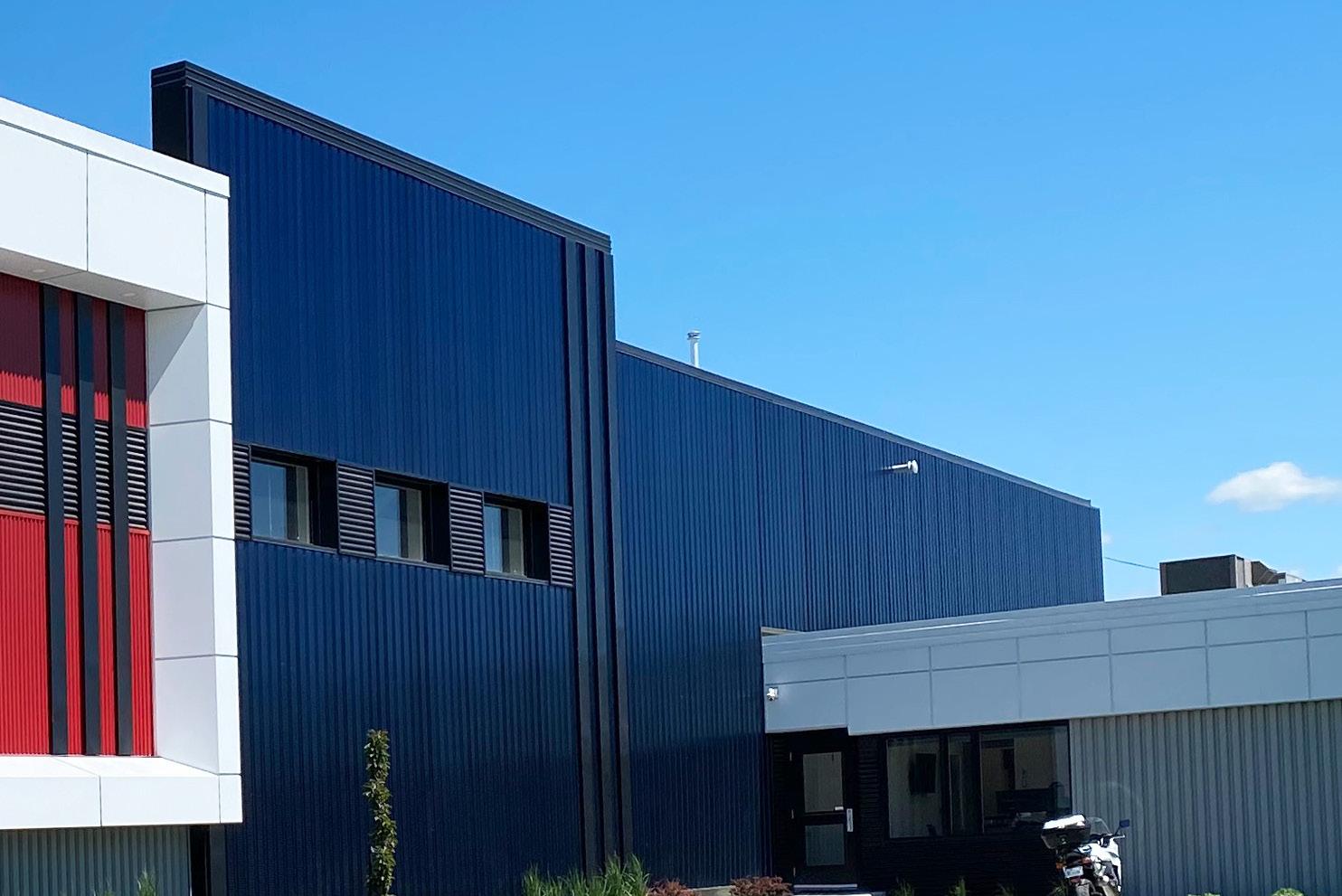

The process starts with a Lidar scan of the existing buildings. The resulting point cloud is used to determine the building geometry and the locations of key elements. These dimensions are turned into panel drawings which are sent to the panel factory. The stakes are high. A mis-sized panel or misplaced window will grind the installa tion operation to a halt. Nine buildings in, that hasn’t happened yet. While the 2x4 framed panels are being manufactured, the buildings are prepared for their arrival. Porches and decks are removed. A hydro vac crew creates a slot to the footing, allowing 5” of lower-carbon, graphite-infused EPS insulation to be added to the basement walls. An insulated PWF panel support box will support the new panels, decks and porch roofs, accommodate service penetrations, and provide a base for parging. The overhangs are removed to allow for a continu ous air barrier over the old roof surface.
When the panels arrive on site, original windows and doors are removed, and the panels are flown into place by a crane. Each panel includes the primary air barrier, vented rain screen, and new highefficiency windows and doors. They are tied back to the existing structure as they are put in place. A finishing carpenter follows the panel crew, installing new window returns and casings. Once a build
ing has been covered in panels, cellulose insulation is blown into the cavity between the panel and the existing structure. The cellulose provides about R 28 in new insulation, for a total of R40 including the original wall. A new scissor truss roof provides space for an additional R 50 of cellulose and a new air barrier over the existing roof. Testing so far indicates that the airtightness target of less than 0.7 ACH 50 is being met. The remaining heat load can now be met by air source heat pumps. After installation of air source heat pump water heaters, the old fossil-fuel gas lines are decommissioned. A solar PV system will provide about 80% of the remaining electrical load, with the balance being purchased from renewable sources. By the end of the process, the envelope and mechanical specifications are very similar to a new net zero build.
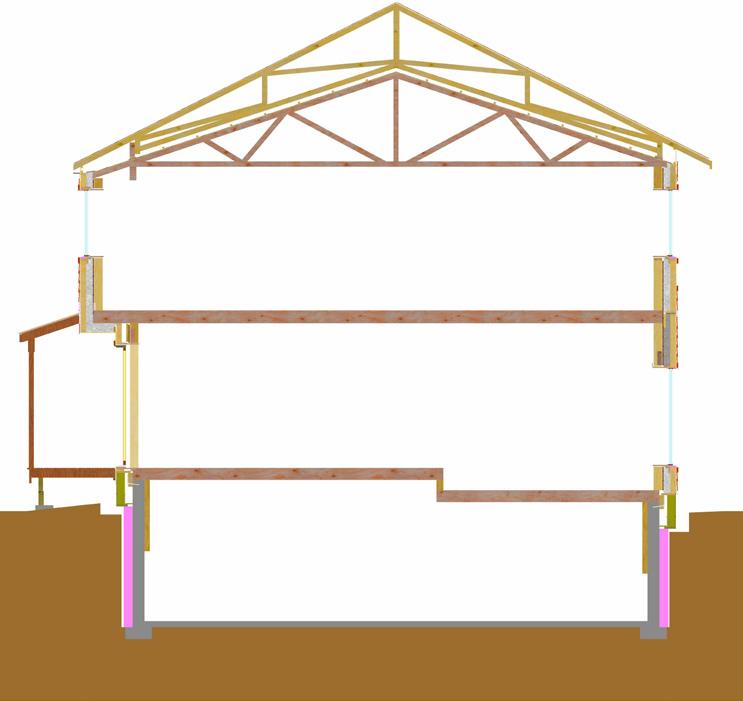
Butterwick Projects is also currently retrofitting three single-family homes, with the backing of the Smart Sustainable Resilient Infrastruc ture Association (SSRIA). These homes, typical of Edmonton housing stock, get a similar digital capture and panelization treatment, and will further develop the processes required to retrofit at commercial scale.
In Ottawa, a retrofit of four 70-year old townhomes has been com pleted using similar techniques. Ottawa Community Housing per formed the work themselves, with design and detailing assistance from Cold Climate Building and If Then Architecture, as well as support from Natural Resources Canada.

with sustainable building envelope technology
InSpire is not just a wall panel, this is a solar collector and fresh air heating system that reduces your operating carbon footprint. InSpire HP uses a new selective surface to reduce thermal radiation losses, and enhance absorptivity and efficiency.


InSpire HP in Select Blue
Thetford Mines, Quebec, Canada
Architect: Construction Gosselin-Tremblay Inc
Contractor: Refrigeration Thetford Inc
Distributor: Trigo Energies inc.


The fact that, as an industry, we are only now doing pilot projects is alarming, given the scale of the challenge. Around 40% of Canada’s total emissions come from the buildings we live and work in. Of the buildings that will be around in 2050, 70-80% are already standing. Reaching zero emissions from existing buildings is an immense challenge. If Canada is to reach this target, we will have to retrofit a lot of buildings. The time frame and the cost mean we need to do it as carefully and as efficiently as possible
Partial and “piecemeal” upgrades the kind encouraged by most incentive programs can do more harm than good. People are picking the low-hanging fruit without a plan to get to net zero, adding medi ocre windows that are a slight improvement, adding attic insulation without air sealing, and re-siding with some insulation but not enough. Not only do these partial upgrades not solve the problem, they undermine the business case for a more holistic deep retrofit, and lock in the remaining emissions. Typically, we get one chance per building. The money spent on partial upgrades, particularly if some of it was spent renewing the exterior, will be next to impossible to find again for any future net zero retrofit.
Aside from the obvious motivation avoiding planetary catastrophe deep retrofits provide a chance to transform buildings in a relatively cost-effective way. Reduced energy costs are an obvious benefit, and while we don’t know what mix of energy solutions will make up our future zero-emissions grid, everything points to a significant price increase. A deep retrofit can also fix deferred maintenance problems, and reduce future long-term maintenance costs by employing the best building science. Improved comfort is also a major factor: regardless of how residents feel about the climate emergency, they can appreciate
a quiet, climate-controlled, draft-free home with a window seat in every window. In some cases, retrofits can also be used to fix previous aes thetic blunders and realign the building with the original designer’s in tentions. All of these things increase resale value. Viewed through this total-cost-of-ownership lens, the upfront cost makes sense.
A useful example of how the industry can scale up can be seen in the Netherlands Energiesprong initiative Dutch for “Energy Leap”. This program for rapid retrofits provided the conceptual basis for the Sundance pilot project. The panelized retrofit technique the Dutch teams have developed is well optimized for the regular, predictable row houses they currently focus on, which are much simpler than the complex forms of Sundance. They have succeeded in making the process minimally inva sive for residents, using 3D scanning, factory-built panels, and even new mechanical equipment packaged into integrated, plug-and-play pods. Deep retrofits may seem like a limited niche, but Energiesprong shows that they can become big business. One of the main companies working in this space in the Netherlands is multibillion-euro construc tion giant Volker Wessels a multinational infrastructure company that builds bridges and stadiums, is responsible for a portion of the UK’s HS2 rail line, and holds road maintenance contracts as far afield as Alberta. Over 10,000 homes have been retrofitted in the Netherlands, and similar projects are underway elsewhere in Europe.
In order to connect the projects happening across the country and share their learning, members of the Sundance project team and champions of retrofits from across the country have formed an organ ization called Retrofit Canada. The primary goal of Retrofit Canada is to open-source the knowledge coming from these pilot projects. They are developing several tools to facilitate knowledge transfer and make newly developed processes accessible to the rest of the industry. The tools include a growing collection of retrofit case studies, from townhouses and bungalows to apartment buildings. The team is also developing a ‘retrofit roadmap’ to help others through the challen ges from the technical challenges of digital capture, 3D scanning, and envelope detailing, to tips for managing resident relations and obtaining financing. Knowledge is being shared openly between pro jects. With millions of potential retrofits spread between every town and city in Canada, there’s more than enough work to go around.
How do you build an industry overnight? Answering this question will unlock immense opportunity, but there are many things we need in order to get there. We need more pilot projects both to learn, and to demon strate the viability of retrofits, with examples in different regions and building types. We need to push for policies and programs at all levels of government to help support this climate action. We need to ensure that architects, engineers, energy evaluators, designers, contractors, trades, manufacturers and lenders are all on the same page. We need to attract, train, and retain the workforce by showing them there is a prosperous and stable future in this work.
And then we need to retrofit a few million buildings.
Peter Amerongen is leading the design of the Sundance project and is a co-founder of Retrofit Canada. He has been designing and building energy-efficient housing in and around Edmonton since the 1970s.
Max Amerongen is a designer and writer in Edmonton, working on topics including heritage, unbuilt architecture, and climate.
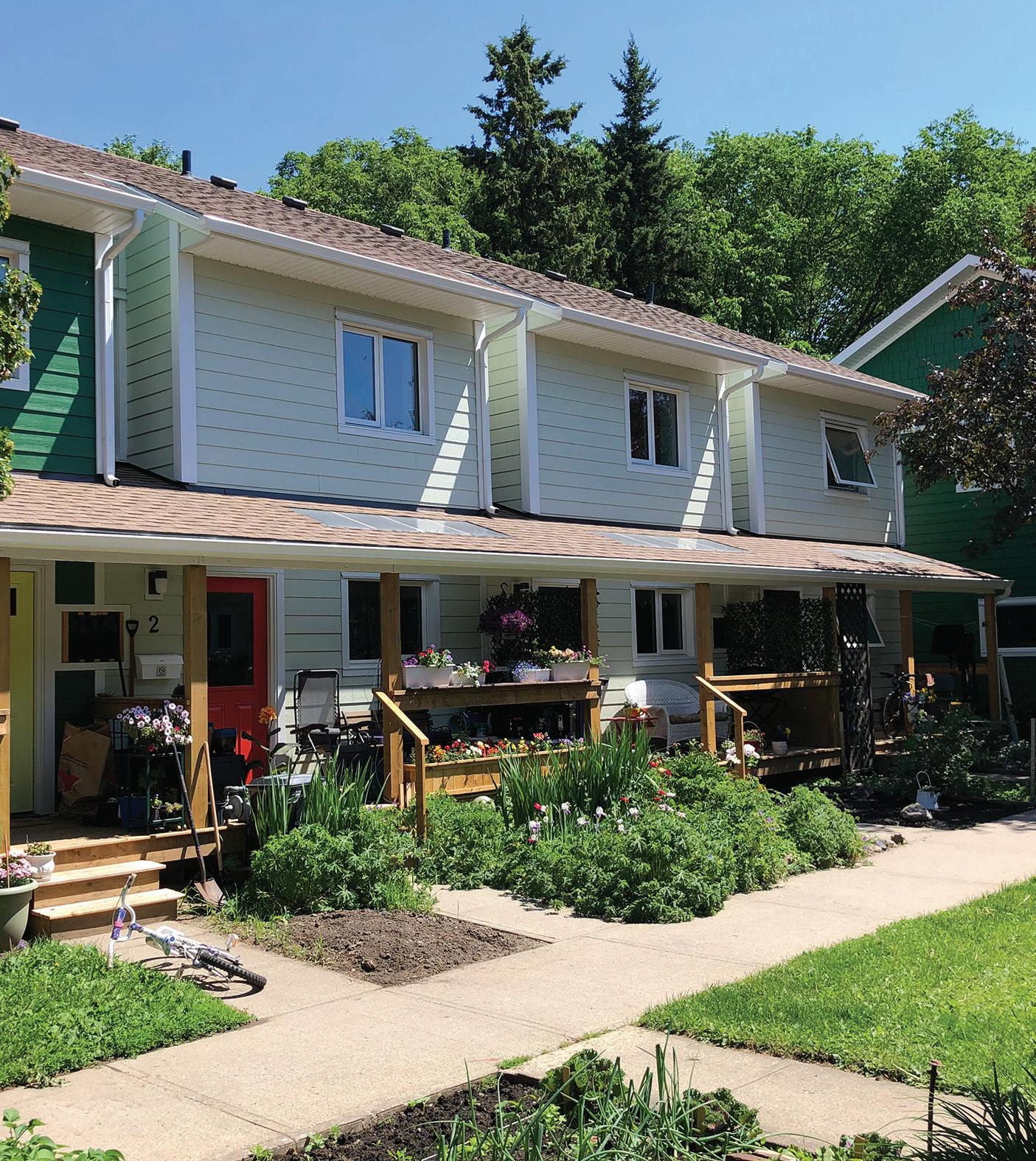



Most industry embodied carbon targets and benchmarks focus on architectural building materials, without considering the embodied car bon impact of mechanical, electrical, and plumbing (MEP) systems. But more and more studies are now revealing just how significant the embodied carbon impacts of our MEP systems can be.
Integral Group recently completed a study comparing different resi dential space heating options in the UK . The embodied carbon emis sions associated with a Variable Refrigerant Flow (VRF) split system, with refrigerant for heating and/or cooling, was about 800 kg CO2e/m2 over 60 years equivalent to a third of a typical home’s total operational energy use over that time. Additionally, in a study of an eight-storey of fice building, we found that the mechanical system design’s embodied carbon could be, to our own astonishment, equivalent to that of the building’s structure and envelope combined.
Until now, the industry hasn’t been considering the embodied carbon emissions from the MEP equipment that enable our buildings to oper ate efficiently. Clearly, that needs to change.

Just how much do these MEP systems contribute to the overall mass in a building? One study by the Carbon Leadership Forum (CLF) esti mates that the mass of MEP equipment in a typical office building in the U.S. Pacific Northwest can range from 14.6 to 22.7 kg/m2 roughly the weight of six four-litre water bottles stacked on each square metre. It would be far greater in labs, health care facilities or data centres.
MEP systems are made largely from high embodied carbon metals for instance, aluminium for electric motors and heat exchangers; copper for internal pipework; rare earth metals for electric batteries and solar PVs; steel for enclosures, support rails, and ductwork; cast iron for pipework; and a combination of metals for boilers and chillers. Cur rently, due to the low recyclability of most of these equipment types, virgin metals need to be mined, treated, and processed a highly energy intensive endeavour to create new equipment. Moreover, since global mining is concentrated in a handful of countries, these metals must be transported over long distances to the manufacturing facilities where the final products are created. Ethical sourcing and forced labour issues
in-use period
ABOVE MEP systems have an embodied carbon footprint throughout the lifespan of a building.
are also a deep concern in the supply chain related to the mining, extraction, and manufacturing processes that create MEP systems.
These environmental impacts are compounded by how frequently equipment needs to be replaced. On average, HVAC equipment, in cluding heat pumps and boilers, requires replacement every 20 years. Most lighting fixtures need to be replaced every three to seven years. This represents repeated carbon impacts during a building’s lifetime.
As more and more all-electric equipment is installed in buildings for cooling as well as heating, the use of refrigerants in such equipment skyrockets. Commonly used refrigerants, such as R410A or R134A, have very high global warming potential (GWP) in the order of 1,000 times the impact of comparable volumes of CO2 and tend to leak into the atmosphere.
In 2019, Integral decided to advance and share knowledge around embodied carbon in MEP designs, in order to make it a top priority for us and the building industry. One of the first things we realized was the need for an industry-wide methodology to assess the embodied car bon of MEP products. This would need to be developed in the absence of Environmental Product Declarations (EPD s) as there were (and still are) a limited number of MEP EPD s.
We have been working with the Chartered Institute of Building Services Engineers (CIBSE) to develop this methodology, including addendums that show how to use this method globally. The method ology was published in early 2021 as Technical Memorandum (TM) 65. TM65 provides a consistent method to estimate the embodied carbon of MEP products when no EPD s are available. Our end goal

All the flooring products that we sell – carpet tile, LVT and nora® rubber – are carbon neutral across their full product life cycle through our third party verified Carbon Neutral Floors™ program. We’ll even calculate the floor’s impact so your customers can see their contribution to reducing global warming.
















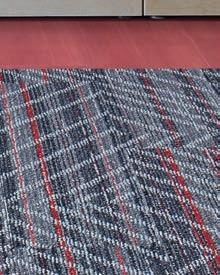



Learn more at interface.com/carbonneutral

GWP meeting climate targets
not meeting climate targets
CENTRALISED SYSTEM
COMMUNAL HEAT PUMP CHILLER
REFRIGERANT CHARGE
BEST REFRIGERANT OPTIONS:
AMMONIA CO2 WATER PROPANE R1234ze R1234yf R32 R513 a R134 a R07c R410 a LEAKAGE RISK NOT NECESSARY SEALED CHARGE REDUCTION
HEATER INTERFACE UNIT
WATER COOLED UNIT
ABOVE A summary of some of the steps
VRF
SYSTEM
INDIVIDUAL
SPLIT DX
PACKAGED INDIVIDUAL HEAT PUMP
BEST REFRIGERANT OPTIONS:
AMMONIA CO2 WATER PROPANE R1234ze R1234yf
R32 R513 a R134 a R07c R410 a
LEAKAGE RISK TYPICALLY HIGH DISTRIBUTION LENGTH CHARGE REDUCTION

DISTRIBUTION LENGTH
HYBRID VRF
REFRIGERANT CHARGE
AMMONIA CO2 WATER PROPANE R1234ze R1234yf
R32 R513 a R134 a R07c R410 a
ASHP, WSHP, CLOSED LOOP
LEAKAGE RISK - SPLIT NOT NECESSARY SEALED
LEAKAGE - PACKAGED SMALL CHARGE - SEALED AND PRECHARGED BUT CAN ADD UP TO # OF UNITS
CHARGE REDUCTION ALREADY MINIMAL BUT STILL NEED TO MAKE SURE TO ADDRESS REFRIGERANT LEAKAGE
the carbon impact of refrigerants.
is to create a knowledge bank and meaningful rules of thumb that can assist all engineers in making the right decisions early in the design, which is when we can have the most significant impact.
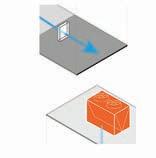
Today, many manufacturers that stepped up to provide information for TM65 calculations are asking us what next steps they can take to produce EPDs for their products. This is a huge win for the industry, and will escalate progress towards embodied carbon data transparency and accessibility for MEP systems.
As part of this research effort, we have explored the embodied carbon of MEP designs at different levels, from the product to the overall building. Here are some examples of these studies.

In this technical report, we explored the embodied carbon impact of different rooftop solar PV installations in the UK , and compared them against the operational carbon benefits. When including all equipment associated with the installation of PV inverters, cables, optimizers, support, etc. we found that the overall embodied car
bon impact over the 25-year-lifespan of a system was around 100 kg CO2e/m2 of the building’s footprint. This impact was more than offset by the operational carbon benefits of the system. We calculat ed that 2000 m2 of PV could generate 87% of the energy required by a UK school, while representing 16% of the school’s embodied carbon impact.
In CIBSE TM65.1, we looked at the embodied carbon of typical space heating and hot water systems in highly insulated new-build homes. Our study tested 13 different strategies in a notional three-bedroom terraced home and a two-bedroom apartment. Depending on the heating design strategy, we found that space heating and hot water systems could represent between 1% and 9% of the upfront embodied carbon impact, and over 60 years, between 3% and 25% of the total embodied carbon impact. When refrigerant leakage is included in the calculations, the embodied carbon impact of the space heating and hot water systems can reach 832 kg CO2e/m2 in the case of VRF sys tems exceeding the total embodied carbon impact of the building’s initial construction.

Workers completed a three-year rehabilitation project on the Robert B. Diemer Treatment Plant, where the updates will improve water quality and plant efficiency. The facility serves nearly 3 million people in Orange County in California.


The $38.5 million project included the replacement of a wide range of equipment, including valves, actuators, flocculation and sedimentation equipment and the reinforcement of concrete frames and filter decks. Workers will access equip ment through 10 stainless steel doors manufactured by BILCO. The 10 single- and double-leaf doors are frequently used at water treatment plants.
“BILCO hatches were selected due to their dependability and reputation with the plant. The fact that these hatches are made with quality stainless steel to the dimension we required and have a drain port built in were important features.”
– Eber Luquin, Project Engineer, Environmental Construction
• The Diemer West Basin is an essential lifeline for people in Southern California. It is one of the largest in the nation and is part of the Metropolitan Water District of Southern California, which is the largest supplier of treated water in the United States.
• The equipment in the facility needed to be replaced due to age. Much of the mechanical equipment had become inefficient over time, and some pieces contained PCB properties.
• BILCO floor access doors are engineered with lift assistance for easy opening, and an automatic hold-open arm that locks into the open position to ensure safe egress.
• The doors are also made with corrosion-resistant materials, which is of particular importance at water treatment plants. Heavy-duty construction and a positive latching mechanism help prevent unauthorized access.
INCORPORATE PASSIVE DESIGN STRATEGIES LIKE DAYLIGHTING, NATURAL VENTILATION, AND SENSIBLE WWR TO "DESIGN OUT" MEP SYSTEMS AND REDUCE OVERRELIANCE ON BUILDING SERVICES EQUIPMENT
REDUCE OVERALL REFRIGERANT CHARGE NEEDED (E.G. USE HYBRID VRF INSTEAD OF STANDARD VRF)
USE LOW GLOBAL WARMING POTENTIAL (GWP) REFRIGERANT (<150)

ENSURE LOW LEAKAGE RATES DURING SYSTEM USE AND INSTALLATION ENSURE REFRIGERANT RECOVERY AT END OF USEFUL PRODUCT LIFE
EARLY
CONDUCT LCA EARLY TO INFORM DESIGN DECISIONS
USE EFFICIENT EQUIPMENT WHILE SPECIFYING LOWEST
WEIGHT POSSIBLE
M INIMISE LENGTH OF DUCTS AND PIPES
A SK FOR PRODUCTSPECIFIC EPDS
S PECIFY ROBUST EQUIPMENT WHICH WON'T BE REPLACED OFTEN
ENSURE EASY ACCESS FOT EQUIPMENT INSPECTION, MAINTENANCE AND REPLACEMENT
4. Mitigate refrigerant leakage. Increasing air pollution and warmer temperatures are requiring more mechanical cooling. Moreover, as elec tricity grids decarbonize, the use of heat pumps and variable refrigerant flow (VRF) systems is becoming more widespread. When designed correctly, these systems can deliver significant reductions in energy demand. However, their operational carbon savings can be negated when the embodied carbon impact of refrigerant leakage is factored into the whole-life carbon emissions.
Refrigerant leakage varies by equipment type, and the GWP of dif ferent refrigerants also varies. Specify low-GWP refrigerants that have low leakage rates. Reduce the overall refrigerant charge by right-sizing equipment and, where possible, specify factory-sealed equipment to minimize leakage during transportation and installation. At the end of the product life, take the necessary steps to capture and recover 100% of the refrigerant during decommissioning.
To help engineers and other designers make informed decisions on selecting systems and refrigerants with the least environmental impact, we authored Refrigerants & Environmental Impacts: A Best Practice Guide
ABOVE Key steps to mitigate the embodied carbon of MEP systems.
MEP as share of an office building's overall embodied carbon
In an early study, we found that, over 30 years, the impact of MEP can represent between 15%-49% of a commercial building’s total embodied carbon (including PV systems and refrigerant leakage).
In the case of a retrofit, it can be up to 76%.
How can architects reduce the impact of the embodied carbon of MEP systems in their designs? Here are the key strategies that have emerged from our research so far.
1. Prioritize passive design. Take a “fabric first” approach and incor porate passive design strategies like good daylighting, natural ventila tion, and sensible window-to-wall ratio to “design out” building servi ces as much as possible. In CIBSE TM65.1, our research showed that upgrading the envelope performance from business-as-usual (30 W/m2 load) to Passive House design standard (10 W/m2) leads to a 40% em bodied carbon reduction of the mechanical equipment alone.
2. Incorporate the philosophy of “less is more.” Assess the project program to determine where mechanical systems can be eliminated altogether. When they do need to be designed, collaborate with the project engineers to specify equipment with a lower weight. Look for efficiencies of scale, too. Our research has shown that having one, lar ger-capacity piece of equipment has a lower embodied carbon impact compared to multiple pieces of equipment providing the same total cap acity. In another study, we found that by downsizing equipment and integrating it with architectural design (in this case, choosing a con crete slab with radiant cooling over a typical steel structure with VRF cooling) reduced the whole-life carbon emissions by at least 40% over a business-as-usual all-electric building.
3. Adopt circular thinking. Ensure easy access for equipment inspec tion, maintenance, and replacement. Specify products and components that can be easily demounted, disassembled, reused, or recycled at the end of their useful life. Give preference to manufacturers that offer take-back programs and promote Extended Product Responsibility. Additionally, explore Products as a Service (PaaS) models for leasing equipment, instead of owning it outright. Most MEP products are materials-intensive but have short lifespans. It’s important to work towards using those materials longer.
5. Conduct Life Cycle Assessment early. Work with the engineer and LCA consultants to start developing and analyzing LCA models as early as possible in design. Iterate and refine the results to inform better design decisions. Think holistically about operational and embodied carbon im pacts, as these are highly interconnected when it comes to MEP systems.
6. Ask for EPDs. Advocate for data transparency by requiring productspecific EPDs during bidding and procurement. When EPDs are un available, methodologies such as CIBSE TM65 can be used to calculate the embodied carbon impacts associated with MEP systems.
7. Support the MEP 2040 Challenge. Working with the Carbon Leadership Forum, Integral Group is one of the founding signatories of the MEP 2040 Challenge. This initiative calls for MEP engineering firms to work towards total lifecycle decarbonization, including embod ied and operational carbon. As an architect, your support of this chal lenge is valuable, as it contributes to helping raise awareness of this issue throughout the industry.
8. Don’t forget operational carbon along the way it’s all about Whole Life Carbon thinking. Shifting our focus away from oper ational carbon and solely onto embodied carbon would be a mistake. Instead, we must adopt a Whole Life Carbon approach to designing our buildings, which considers both operational and embodied carbon. We are involved in different industry working groups, such as ASHRAE and CIBSE , to create more knowledge on this next frontier.
Energy efficiency should remain a top priority, but we also need to broaden our thinking to ensure that we also select the lowest em bodied carbon options available with the lowest GWP refrigerant. The time for action is now!
Louise Hamot (M. Arch, MSc Eng,) is the Global Lead of Sustainable Innovation at Inte gral Group and has been instrumental in creating industry knowledge about MEP em bodied carbon. She is the primary author of CIBSE TM65 – Embodied Carbon Calcu lation for Building Services Equipment, and several studies on the subject.
Kanika Aurora Sharma is an Associate Principal and the Sustainability team lead for Integral’s USW offices. She spearheads Whole Life Carbon work in the US, working closely with clients to deliver high-value, high-quality analysis, starting early in design through construction and procurement, for better decision-making on embodied car bon emissions reductions.
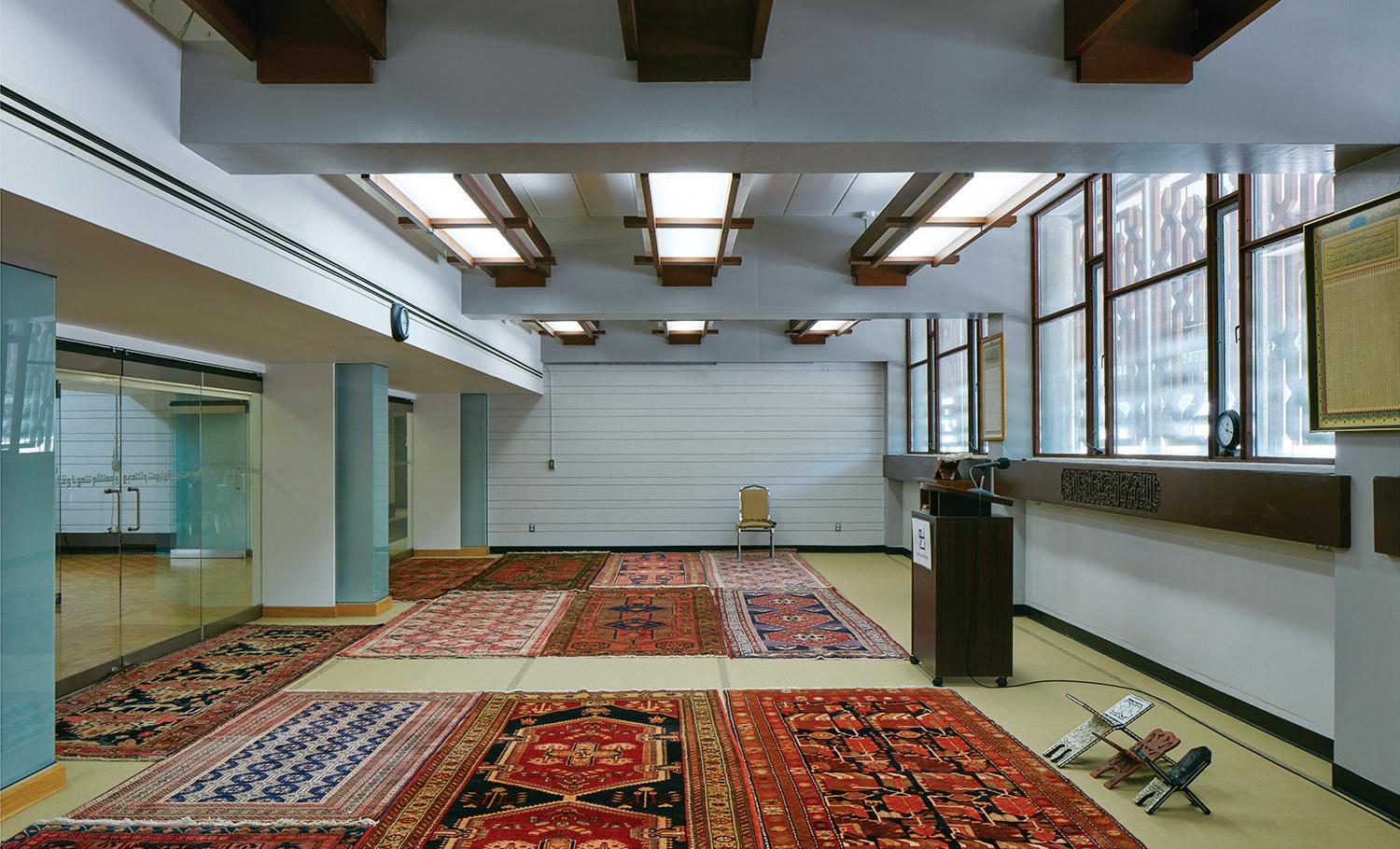
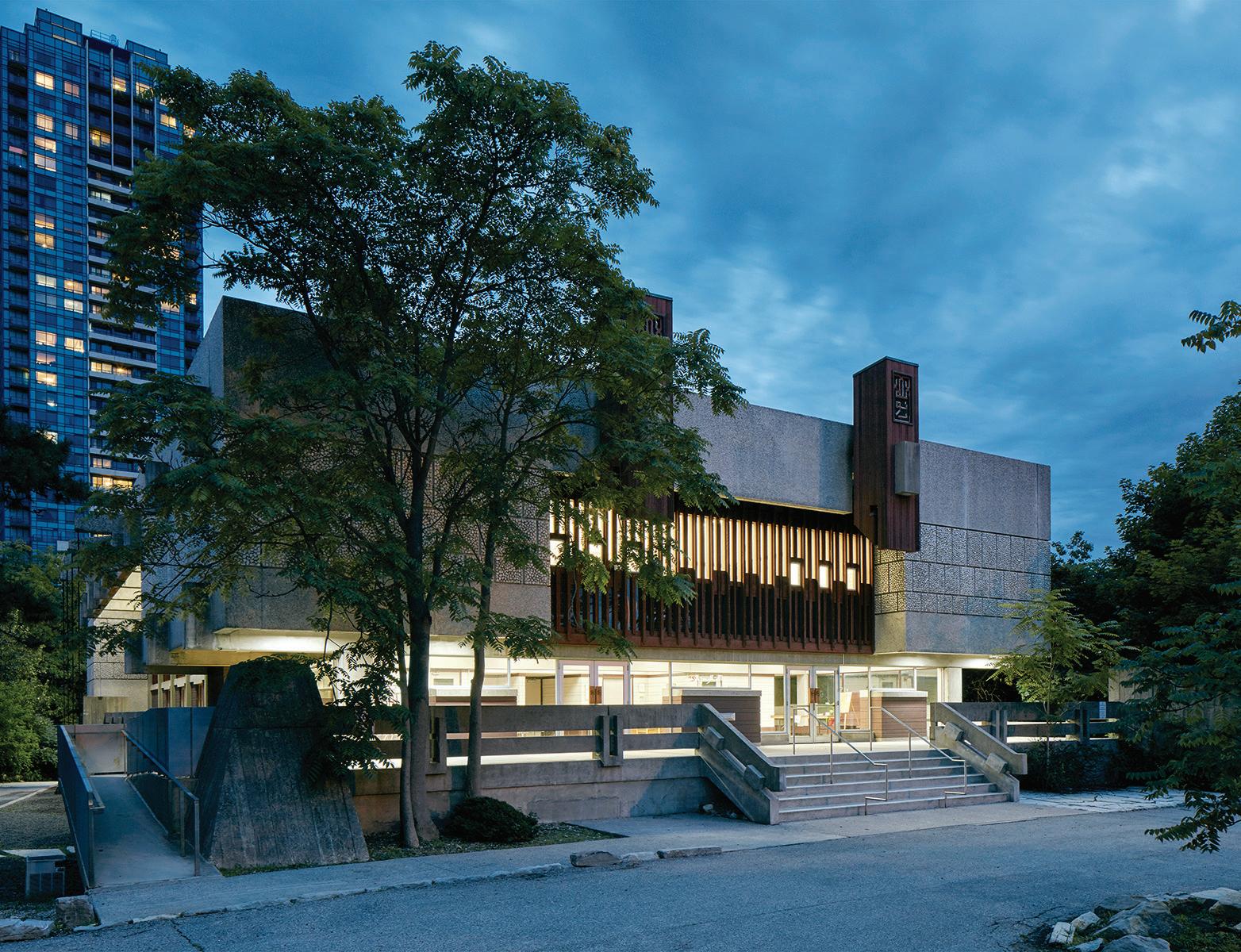 By Tammy Gaber (McGill-Queen’s University Press, 2022) REVIEW Roberto Chiotti
By Tammy Gaber (McGill-Queen’s University Press, 2022) REVIEW Roberto Chiotti
Beyond the Divide: A Century of Canadian Mosque Design provides a critic al contribution to the international scholarship on the architecture of mosques and the social roles they play in diaspora Muslim commun ities throughout the world. Tammy Gaber has gifted our profession with a timely, welcome, and first-of-its-kind comprehensive study of Muslim sacred/social architecture here in Canada.
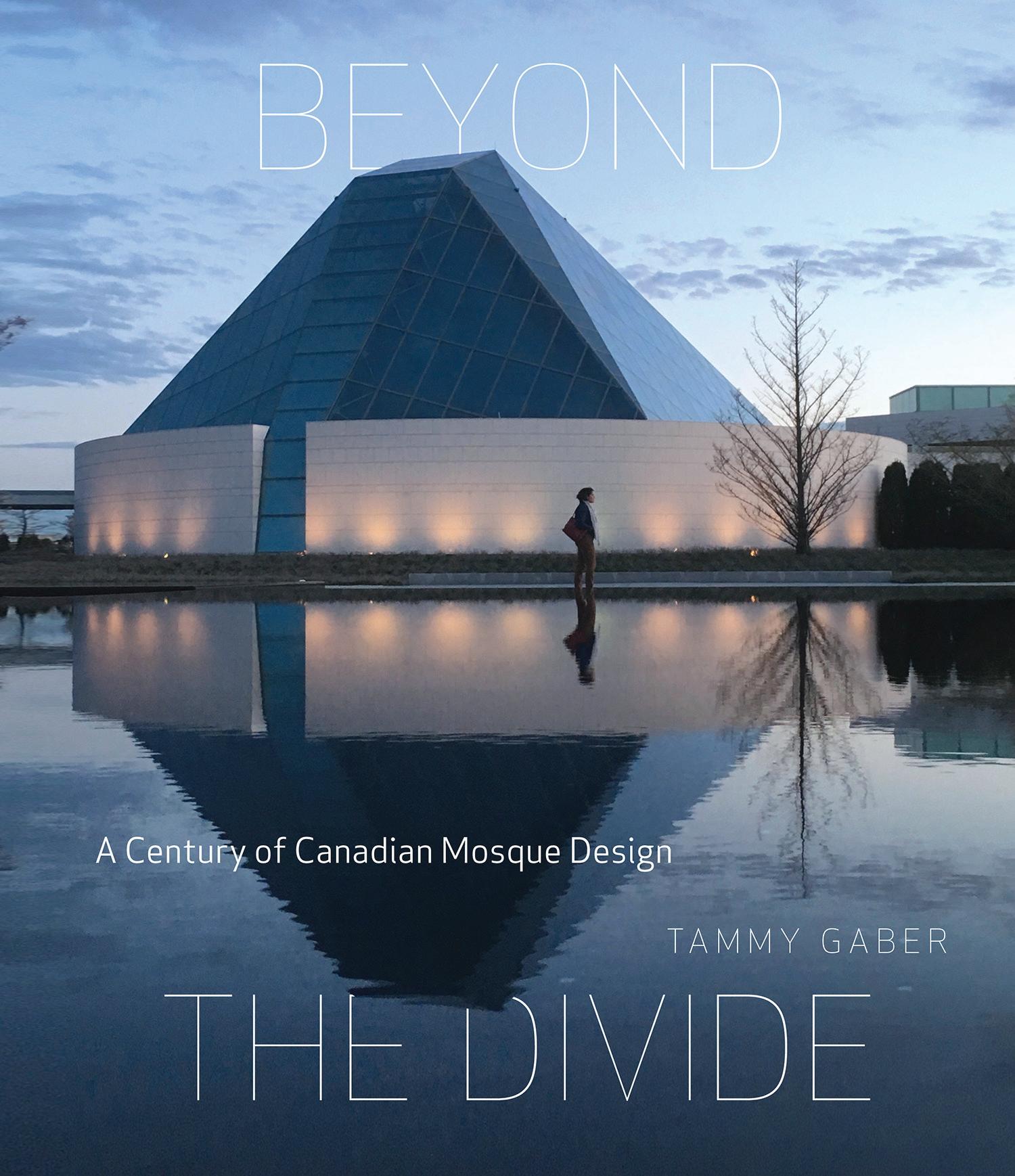
Gaber’s research to create this in-depth record and analysis of half of Canada’s 180-some mosques was spread over nearly three years, and took her to 53 cities across 12 of Canada’s provinces and territories. The result is a rich review of the histories and contributions of Can adian Muslims over the past century. In each case, the mosques are documented with photographs taken in different light conditions to highlight architectural details, drawings either existing or produced from on-site measurements taken by Gaber archival records, and interviews with mosque users, members of their governance, and occa sionally the architects who designed the buildings. In Gaber’s words,
“This book explores the mosques of Canada in their diversity, beauty, practicality, and versatility,” with emphasis always on the story of the mosques and the Muslim communities they serve.
In her introduction, Gaber shares that it is equally important to ana lyze both the exterior and interior qualities of mosques. She has found that “the former is universally privileged in surveys of mosque design,” however, “the latter is not as celebrated in surveys, but fleshes out a more complete story of how the mosque is used.” To this end, she has incorporated extensive interior photographs and included architectural floor plans of every mosque surveyed. Gaber acknowledges that her qualifications as an architect, architectural educator, and Muslim woman afforded her access that would otherwise be difficult to achieve. This allowed her to experience first-hand the phenomenological, sensory qualities of a mosque as expressed through its material choices, textures, proportion, scents imbued from cooking and incense, qualities of light, and amplification of sound particular to certain areas of the building.
As an architect engaged in the design of sacred space, with a par ticular interest in the adaptive reuse of historic churches, I found it of interest that over a third of the mosques Gaber studied were located in converted facilities former churches, houses, retail shops, banks, restaurants, a funeral hall, a casino and even a gas station. This repre sents an important precedent for those of us advocating to save our cur rent building stock wherever possible, as a significant contribution towards sequestering carbon and reducing GHG emissions.
In both the converted buildings and purpose-built mosques stud ied, Gaber identifies four trends of exterior design. She characterizes these as: anonymous, neo-historicist, abstracted historical, and con temporary. Under this latter category, she notes the significant contri bution of the Aga Khan, leader for the Ismaili community, who re ceived the prestigious RAIC Gold Medal in 2013 for his patronage in supporting the construction of numerous Jamatkhanas and Ismaili Centres here in Canada. Architects Gulzer Haider and Sharif Senbel are also acknowledged for their scholarship and design of mosques and Islamic centres in Canada.
The challenging issue of establishing a mosque’s orientation to Mecca and the calculations of prayer times specific to each region and city in the country forms another area of enquiry, with the key direc tion carefully identified in yellow on each of the mosque floor plans. Finally, Gaber also gives attention to the space in each mosque divided according to gender. She identifies that historically, from the inception of the faith, Muslim places of worship were not segregated by gender. However, a centuries-long process of historical developments in Islamic cultures has led to the perceived need to segregate space, which has spread according to local cultural norms. To demonstrate the signifi cance of this delineation, Gaber has colour-coded her floor plans to
indicate spaces dedicated exclusively to men or to women. Each space dedicated to women’s worship is further characterized as having a full view of the main prayer area, a partial view, or no view for women. Gaber’s research explores the impacts that each model has on the com munity life of the mosque and its governance structure, especially with respect to Muslim youth and women.
For architecture students, practitioners, and educators, Gaber’s book provides some important insights about the design of mosques. First and foremost, the impact of mosque designs can be far-reaching: bricks-andmortar decisions can and will profoundly influence whether or not the youth and women within a local Muslim community engage and take ownership of a mosque’s spaces. Second, the architecture of mosques can be contemporary and contextually relevant, using local materials, region al forms, and other references to create a meaningful Muslim landmark, without having to rely on historicist references that can be alienating to both users (who may be of diverse backgrounds) and others within the larger community. Third, architects and architecture students designing mosques need to treat each commission as a unique exercise, not behold en to preconceived taboos or ‘norms’, and to resist taking at face value statements made by the governance board. Rather, there is a need to en gage deeply with the worshipping community, and to solicit their critical feedback and design input.
Indeed, whether or not one is involved in the design of mosques, Gaber’s book offers important lessons-learned about client engagement, the adaptive reuse of buildings, and regional influences on Canadian architecture that make it a worthwhile addition to any office’s library.
Toronto Community Housing is pleased to announce that we are moving to a quality-based selection process for the public procurement of architectural and engineering consulting services. We are seeking innovative architectural firms to work with collaboratively to preserve and renew our portfolio assets, raise the quality of design services, and act as partners to greatly enhance occupant comfort and improve the quality of tenant lives.

In the opening chapter of his memoir, architect A.J. Diamond recounts a conversation with Vladimir Putin. Following the lengthy and aston ishingly bureaucratic design and construction process to build Saint Petersburg’s now-iconic Mariinsky II Theatre, the renowned Canadian practitioner chronicles a complex development saga, capped off with a quip from the dictator himself. So impressed was Putin with Dia mond’s design that he compared it to the works of Italian architects that designed much of Saint Petersburg in the 18th century. “They did a good job, as you have done here,” Putin told Diamond. “We did not let them leave the country.”
It’s a fleeting anecdote, but one that illustrates the breadth of an un commonly varied and eventful architectural career. In the newly pub lished Context and Content: The Memoir of a Fortunate Architect, Abel Joseph “Jack” Diamond reflects on 60-odd years of architectural prac tice, as well as a personal journey spanning from a childhood in South Africa to a rugby career in the United Kingdom, and culminating in a leading place in Canada’s contemporary architectural canon.
Born in 1932 in the South African town of Piet Retief, Diamond traces a rustic childhood and a long family history. Told in elegantly simple prose, the intimate narrative touches on formative memories, Jewish faith, the Holocaust, race relations and more, situating Dia mond’s life and work within an impressively broad context. For better and worse, it is a memoir first and an architectural book second, with Diamond’s design career folded into the more fundamental stuff of life.
Still, Diamond’s lucid and succinct narrative offers insight for the architectural reader and his reflections on working with Louis Kahn are an early case in point. Upon graduating from the University of Cape Town and enjoying an outstanding rugby career at the University of Oxford, Diamond, who was looking to escape apartheid-era South Africa, enrolled as a Master of Architecture student at the University of Pennsylvania, where Kahn was a faculty member.
While Diamond was a student, Kahn’s seminal Richards Medical Building was under construction on campus. Diamond likens the foun dational interplay of laboratories and supporting functions or ‘served’ and ‘servant’ spaces to the polarities of Karlheinz Stockhausen’s music, or “the power and sweep of Beethoven, compared to the minimalism of Philip Glass.” It’s a culturally and historically attuned reading of design, translating the complexities of architecture into accessible
language. The insight highlights Diamond’s polymathic sensibility, and his ability to communicate architectural ideas to the public.
It’s a talent that would serve him well. After stints in academia and practice including working in Kahn’s office the architect and his wife Gillian eventually settled in Canada, with Diamond establishing the University of Toronto’s first post-graduate program in architecture. It wasn’t exactly love at first sight. “When we arrived in Toronto in 1963, I thought we had made a great mistake,” Diamond recounts. “It seemed a city of Presbyterian narrowness and architectural medioc rity.” Luckily, there was more to the place, and after several years in academia, Diamond became a practicing architect, establishing a sixyear partnership with Barton Myers in 1968, and subsequently setting up an eponymous practice in 1974.
In Toronto’s Baldwin village, the Beverley Place Hydro Block proved a watershed. Combining a contextually attuned scale and fine-grained urban rhythm with substantial density, the five-storey affordable residen tial complex created “housing that shared some of the characteristics of a single-family house a street address and soundproofing between units.”
Completed in 1978, Beverley Place also solidified an influential paradigm. Combining sensitivity to its surroundings with a commit ment to preservation of existing built form, the Hydro Block project and Diamond’s subsequent work in Regent Park helped establish “the bedrock of my practice,” Diamond writes. “I embraced an economy of means, and rejected the imposition of random dramatic forms that ignored the needs of the space and client. This meant paying attention to both the context and the content of the building.”
This simple yet refreshingly cogent ethos would serve Diamond well throughout over half a century of practice. Combining a restrained, yet poetic, sensibility with a businessman’s attention to budget, Diamond exemplified the sober, thoughtful qualities of Canadian modernism par excellence. “The aesthetic of the building should reflect its purpose, not the ego of the architect,” he writes.
As an early champion of adaptive reuse, heritage restoration and ver nacular architecture, Diamond also became a vocal champion for To ronto’s public realm, opposing the Spadina Expressway and the Picker ing Airport in the 1970s, as well as the expansion of the downtown Island Airport in the 2000s. (In recognition of his architectural and civic activism, he also served a five-year term as Ontario’s Human Rights commissioner.)

A pragmatic willingness to work within modest means reaped major international rewards, including cultural commissions such as Toronto’s Four Seasons Centre, Montreal’s La Maison Symphonique, Lubbock, Texas’s Buddy Holly Hall and Saint Petersburg’s Mariinsky II Theatre. Aided by Diamond’s long-held passion for acoustics, the firm now known as Diamond Schmitt Architects (established in partnership with Don Schmitt in 1989) became a leading force in cultural and civic architecture. From Israel’s Jerusalem City Hall to the breathtaking (yet ultimately un successful) late-career competition entry for London’s Holocaust Memor ial, Diamond’s practice proved as varied and eclectic as his life story.
While Diamond’s intimately personal narrative makes for a vivid reading experience, the lack of greater architectural detail is occasional ly grating. To the book’s detriment, project years are too rarely cited (for example, the 1978 completion of Beverley Place is never specified), with decades and eras melding to blur vital context. But it is hardly a fatal flaw: Diamond has earned the right to look back and tell his story in his own cadence. And like his buildings, his words are some times elevated by their very lack of pretense and grandeur, becoming more than the sum of their parts.
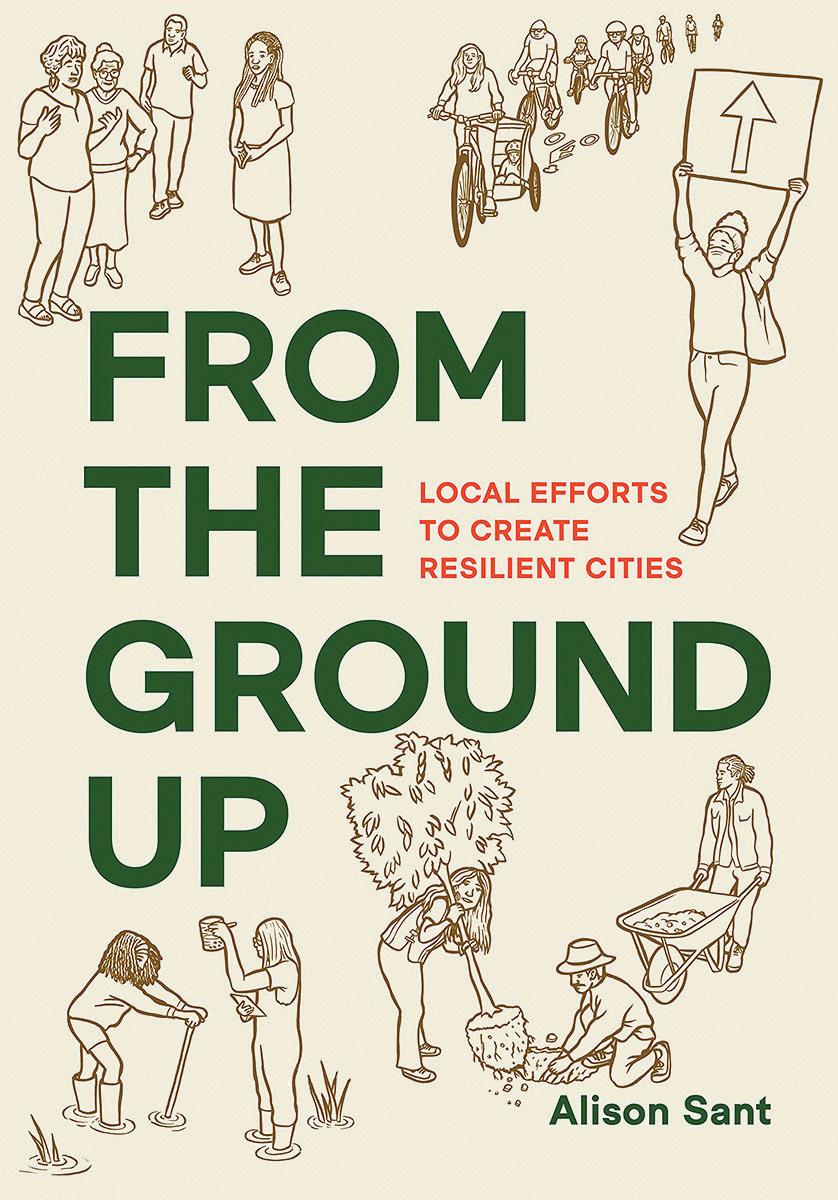 By Alison Sant (Island Press, 2022) REVIEW Anne Lissett
By Alison Sant (Island Press, 2022) REVIEW Anne Lissett
As the climate crisis worsens, and we await strong national and inter national responses to tip the GHG emissions curve downward, it can be hard to remain hopeful. Alison Sant’s inspiring response is to show case how individual communities, local community leaders, and grass roots organizations have put the classic adage “Think global, act local” into action and made real, meaningful improvements to quality of life while reducing carbon emissions in major American cities. Her case studies, starting with simple parking stall conversions in San Francisco, spanning micro-scale storm water management improvements in New Orleans and bikeways and bike-sharing in Minneapolis-St. Paul, to oyster-reef restoration projects in New York City’s harbour, illustrate a range of practical interventions to create more resilient cities in the face of a rapidly changing climate.
No wild technological silver bullets or radical visionaries populate these pages just regular people identifying a need in their city: wheth er a lack of public green space or diminishing urban tree cover, or re developments which could displace existing disadvantaged commun ities. Those same individuals build a coalition of supporters through outreach to neighbours, gain incremental funding, implement their approach, get feedback, and make improvements. Many leaders are people of colour, and they focus on helping their own communities adapt and improve their urban environment without displacing resi dents. Sant interviews key players and quotes them extensively, bring ing firsthand perspectives on approaches they employed and making these people the focus of the cases. These stories show how genuine understanding of a community’s needs, matched with effective public outreach, can build support and get things done, and how the lack of public support can kill an otherwise good idea.
Sant delves into the complex historical and regional scale of each case, especially in the chapter “Living with Water.” Here she examines the history and impacts of flood management in New Orleans how it
ABOVE As part of a grassroots effort to improve green infrastructure in the area, volunteers install stormwater features along a demonstration block in the 7th Ward, New Orleans, in 2020.

allowed the city to thrive since colonization, but also how vulnerable it has made the cityscape to heavy rainfall (never mind catastrophic storms like Hurricane Katrina). We meet Angela Chalk, a local activist who was among the first to return to her home in the devastated 7th Ward and rebuild. The chapter follows her journey form learning about green infrastructure, to implementing measures herself, to becoming an advocate and educating others. Sant then explores a funded, larger scale effort in the 7th Ward to implement a green infrastructure district, and the challenges faced in gaining community support for the project, some caused by the nature of the funding grant itself. Zooming out further, she considers the regional watershed context, and how planners and ecologists struggle to communicate the long-term challenges facing the region to the public. Sant finds answers in the words of her interview ees, showing how leadership at higher levels needs to listen to leaders and experts within impacted communities instead of imposing solutions.
The book is organized into four themes, covering street reclamation, rainwater and green infrastructure, urban tree cover, and shoreline res toration. Each includes a topical essay by other activists and thinkers to supplement the case studies. Most Canadian city dwellers with an interest in building local climate resilience will find a relevant project here. Unlike many environmentalist messages which admonish us to give up the conveniences we are used to, Sant shows how fighting and adapting to climate change can make our cities better for everyone including those with the least resources and can start at home. Sant’s call to action challenges us all to find ways we can improve our cities now, without waiting for national leadership to give us permission. Her vision of inclusive, nourishing, resilient cities, ready for the crisis already upon us, may not be the one we were expecting but it’s the one we need.
Lissett
Vancouver, BC.
a Senior Associate with
Perkins Eastman Studio
Calgary
9/8 –
City of a Thousand Planets
The University of Calgary’s School of Architecture, Planning and Landscape opens an exhib ition that uses graphics, 3D models and interactive pieces to showcase new visions for down town Calgary. sapl.ucalgary.ca
Winnipeg
– 10/14
Unstacking the Deck
An exhibition in the Winnipeg Architecture Foundation’s store front space celebrates early women architects and designers in Manitoba. (See our Backpage in Sept 2022.) winnipegarchitecture.ca
– 12/31
Tapume Artist, architect, and educator Eduardo Aquino’s three-part ex hibition repurposes the covered sidewalk and hoarding wall in stalled during the construction of Qaumajuq as a "found" artwork. umanitoba.ca
Toronto 10/20 –
Housing Multitudes: Reimagining the Landscapes of Suburbia
The Daniels Faculty launches its new exhibition, conceived and curated by Richard Sommer and Michael Piper in collaboration with Daniels Faculty colleagues, students and others. daniels.utoronto.ca
10/27
Alfred Waugh lecture
The founder and principal of Formline Architecture speaks at Toronto Metropolitan Univer sity’s Department of Architec tural Science, considering how design can integrate Indigenous ways of knowing.
torontomu.ca
11/1
Green Building Festival
Sustainable Buildings Canada

hosts its annual conference at Toronto’s Marriott Downtown, with a virtual attendance option. sbcanada.com
11/28
Moshe Safdie: If Walls Could Speak
The Toronto Public Library hosts Safdie for a talk about his new memoir at its Appel Salon in the Toronto Reference Library. torontopubliclibrary.ca
Peterborough
10/18
Ron Thom, Architect
A book launch for architectural historian and journalist Adele Weder’s biography of iconic Can adian architect Ron Thom takes place at the Thom-designed Trent University campus. trentu.ca

Montreal
– 11/6
Drawing Conversations
The current exhibition at UQAM’s Design Centre brings together the work of 16 architects and academics in an exchange on contemporary drawing practices in architecture. centrededesign.com
– 12/2/23
This Indigenous-led exhibition explores how Inuit, Sámi, and other communities across the Arctic are creating self-deter mined spaces. (See our review in Sept 2022.) cca.qc.ca
11/03
Surveillance, Violence, and Truth
Shourideh C. Molavi and Alison Killing discuss how architectural skills can be used to investigate urgent social issues. www.uwaterloo.ca
Ice is elemental. As crystallized water, it might be seen as a building block of life. But it can be a literal building block too: witness the Warming Huts built from ice by Sputnik Architecture, including Anish Kapoor’s 2015 Stackhouse. Ice can serve a social purpose also: bearing goods to remote communities, like Manitoba’s famed Ice Roads; or connecting parts of the city usually divided by water, like Winnipeg’s Nestawaya River Trail. Social con nector, artistic medium, or building material: these are all aspects of ice explored every year by Sputnik Architecture in multiple creative projects carried out in the community.
In 2022 Sputnik worked with Downtown Winnipeg's Business Improvement Zone to produce an ice sculpture trail running from Nestawaya River Trail to the Exchange Dis trict’s Burton Cummings Theatre. The project involved local artists including Hargraves himself, stepping in for Norwegian-Italian ice artist Luca Roncoroni, who was stranded in Europe by the pandemic. Hargraves also worked with Larry Macfarlane, Corby Pearce, and prize-winning carver Manoj Khor ugdharry to create an Ice Palace for the Northern Manitoba Trappers’ Festival in the
northern community of The Pas. And Sput nik worked with Pembina Hill Arts Council and local sponsors to coordinate the second annual ice harvesting and carving workshop on Lake Minnewasta, in southwest Manitoba.
If this seems like the sort of work architects don’t usually get involved with, it is a labour of love for Hargraves and others at Sputnik. Their agenda is to make ice carving part of winter culture throughout Manitoba. To this end they bring in ice sculptors from across the country, recruit local artists to try out ice as a medium, and teach the technique of ice har vesting to anyone who wants to learn it. This is an intentional nod to the past. Manitoba’s win ter festivals once hosted skating rinks, ice cas tles, and towering ice chutes. Ice for these was harvested from waterways, as were blocks for summertime use in “ice boxes.” This practice had disappeared from Winnipeg when it was reintroduced by Sputnik and Roncaroni.
A constellation of tools helps with this pro cess, beginning with an articulated chainsaw developed by Sputnik and its collaborators at the Forks, and ending at the ice stacking and carving stage with an array of scratch boards and razor-sharp chisels, often home-made.

ABOVE Sputnik and its collaborators have developed specialized tools for ice harvesting.
The hope at Sputnik is that these techniques can be mobilized to soon create in Manitoba the kind of Ice Hotel which has become popu lar elsewhere. In fact, Hargraves and Winni peg-based artist Chris Pancoe will be flying to Europe this November to contribute a room to Sweden’s Ice Hotel.
Ice as a medium underlines the ephemerality of all construction: none of these structures last long. But it takes on a particular poignance in light of the current climate crisis and the unpredictable weather that it is producing. Indeed, Stackhouse almost never happened because the entire harvest of ice dedicated to it (over 100 tonnes) melted irretrievably in a mid-winter thaw. Only a heroic effort and a second ice harvest salvaged the situation. Rivers, even Winnipeg’s, are becoming less reliable as a source of ice, and on occasion ice from lakes and quarries has to be used instead. Water is what makes this planet what it is, and ice is water in reserve but a reserve rapidly diminishing. Sputnik’s wintertime works, while they engage and delight us, also remind us that everything passes.
works
Since the day we opened our doors in 1912, as a family-owned and operated cedar and lumber company, we’ve looked for ways to help people live happier and healthier lives. We are committed to design that is as functional and intuitive as it is beautiful. Crafted with exceptional skill, our windows and doors deliver quality you can see, touch, and feel, beauty that brings joy, and performance
Since the day we opened our doors in 1912, as a family-owned and operated cedar and lumber company, we’ve looked for ways to help people live happier and healthier lives. We are committed to design that is as functional and intuitive as it is beautiful. Crafted with exceptional skill, our windows and doors deliver quality you can see, touch, and feel, beauty that brings joy, and performance

stands the test of time.
stands the test of time.

